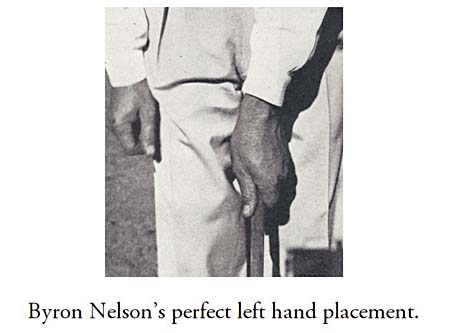
Book Review: The Anatomy of Greatness - Brandel Chamblee
Click here to go back to the home page.
Introduction:
This review paper represents a critical review of the opinions expressed by
Brandel Chamblee in his book called "The Anatomy of Greatness" [1]. Brandel
Chamblee is presently a reknown (albet controversial) Golf TV commentator on the
Golf Channel, and he previously played golf as a professional golfer on the PGA
tour for a 15-year time period. In his book, Brandel Chamblee posted the
following comments in the "About Brandel Chamblee" section of his book-: "Chamblee
has earned a reputation for being one of the most intellectual, accurate,
insightful, and well-researched personalities on Golf Channel. He is known for
his keen knowledge of the golf swing and the history of the game." Based on
those statements, Brandel Chamblee obviously believes that he has great insight
into the mechanics/biomechanics of a well-executed full golf swing and he
harbors strong opinions on what represents the optimum way to perform a full
golf swing. Brandel Chamblee seemingly believes that many modern day golf
instructors are not teaching the optimum way to perform a full golf swing, and
he seemingly thinks that they have lost their way. He apparently believes that
present day golf instructors should go back to teaching the swing elements
manifested by many great golfers from a bygone era (like Bobby Jones, Sam Snead,
Ben Hogan, Arnold Palmer, Jack Nicklaus and Mickey Wright) and he provides many
examples of swing elements that he believes are very desirable. I have no
problem with the "fact" that he harbors strong personal choices when it comes to
desirable swing elements, but he seemingly adopts the radical position that his
personal choices have been proven to be better than the swing elements adopted
by many modern day professional golfers (such as Adam Scott, Jordan Spieth, Rory
McIlroy and Jason Day). I believe that he is wrong about many of his personal
choices - either in terms of their fundamental "essentiality" with respect to a
well-executed full golf swing or with respect to his personal explanations about
the underlying golf swing biomechanics that underpin those swing elements. In
this review paper, I will thoroughly dissect his opinions and provide my
personal (and often contrary) opinions, so that readers of this critical review
paper can independently judge the merits of our respective opinions. I will
basically follow the pattern of chapters as they were presented in Brandel
Chamblee's book in this critical review paper, and I will
mainly comment on swing elements where Brandel Chamblee and I harbor very
different opinions.
Chapter 1 - The Grip
Brandel Chamblee made the following statement in his book-: "Among amateurs there is often some confusion and much error when it comes to placing their hands on the club. I believe much of the problem is rooted in the most popular instruction book ever written." The book that he is referring to is Ben Hogan's "Five Lessons" golf instructional book, and he quoted from the book as follows-: "On page 26 of Five Lessons: The Modern Fundamentals of Golf, Ben Hogan states that, when placing your left hand on the club, the V formed by the marriage of the index finger and the thumb (for a right-handed golfer) should point to the right eye. On page 28 he states that the V formed by the index finger and thumb of the right hand should point to the chin. In professional golf-speak, this is known as a weak grip. Hogan’s was one of the most beautiful the game has ever seen. ---- It was beautiful because he crooked his right index finger, which he called a trigger finger, back just enough to where he could push the top joint into the side of the grip and apply pressure and this cohesiveness, between index finger and thumb, gave his grip an almost unmatched symmetry." However, although Brandel Chamblee describes Ben Hogan's left hand grip as being "beautiful", he also believes that a weak left hand grip will predispose to an open clubface at impact if the clubshaft has forward shaft lean - unless the golfer uses some compensatory maneuver (eg. increased left forearm supination). Brandel Chamblee therefore concludes that a golfer should use a stronger left hand grip, and he states in his book-:"As beautiful as Ben’s grip was, it was unique to him. The vast majority of great players have used a much stronger grip, and most amateurs should, too. A stronger grip is the grip of choice— the commonality among the best in the game— and the easiest path to improvement.
Brandel Chamblee then describes how a golfer should adopt a stronger left hand grip as follows-: "In placing the left hand on the club, the grip should run diagonally from the lower part of the palm, specifically right on the thickest crease in your palm, known as the Line of Heart, across the top joint of your middle two fingers and lay on the middle joint of your index finger. Then the thumb is folded over and placed just to the right of the center of the club. The V formed by the thumb and index finger should point toward the right shoulder. If yours points toward your chin or right eye, keep turning it clockwise until it approximates the greats. --- If one takes up the grip too much in the palm or with the thumb straight down the club, at the top of the swing the hand and thumb will likely not be in position to support the weight of the club and the stress of the transition. Hence, the club should be placed diagonally in the hand, with the thumb on the side of the shaft. The placement of the left hand has a very distinct purpose. The left hand provides the stability in the strike but the full range of motion should never be compromised. The tendency is to take up the grip completely in the palm, but this is disastrous, as the player will lose some range of motion in the wrist and security of the club at the top of the swing."
What Brandel Chamblee is basically describing is a low palmar grip of neutral-to-slightly strong strength (2-3 knuckle left hand grip).
Brandel Chamblee uses the following image of Byron Nelson's left hand grip as a prototypical example of perfect left hand grip placement.

Image copied from reference number [1]
I have no objection to his personal choice of that pattern of left hand grip, which is a very common choice among skilled professional golfers, but I think that his reasoning for choosing a stronger left hand grip and his description of how best to adopt a slightly strong left hand grip is flawed.
Consider the "idea" of using the V-direction as the optimum method of adopting a stronger left hand grip.
Note that Byron Nelson chooses to have his clubshaft perpendicular to the ball-target line at address so that his hands are no closer to the target than his clubhead, which means that he has to disrupt his intact LAFW (defined as a clubshaft that is straight-in-line with the left arm) by bending his left wrist. Under those conditions (with the hands midway between the thighs), the V formed by the left thumb and left index finger will likely point at the right shoulder at address.
However, some golfers prefer to have their left arm and clubshaft straight-in-line (and with forward shaft lean) at address, and that personal choice will affect the direction that the V will point at address.
Consider an example of that personal choice - Dustin Johnson.

Image 1 shows Dustin Johnson at address, while image 2 shows him at impact.
Note that Dustin Johnson has his clubshaft straight-in-line with his left arm at address, which means that his left wrist is not bent - even though it may "appear" to be bent in that image. However, the "real" reason why his left wrist is dorsiflexed at address is due to the "fact" that he adopts a moderately strong (3-knuckle) left hand grip with his left thumb placed on the aft side of the grip handle. Note that the V formed between his left thumb and left index finger points at his chin, and not at his right shoulder, at address - even though he has adopted a moderately strong left hand grip. That's why one should not assess the strength of a golfer's left hand grip at address using the V-direction technique - because of the additional biomechanical variable of hand position at address, and whether the golfer arbitrarily/preferentially decides to have a forward angulated shaft at address (like Dustin Johnson where his hands are closer to the target than his clubhead) or whether a golfer prefers to have the clubshaft perpendicular to the ball-target line at address with his hands not being closer to the target than the clubhead (like Byron Nelson).
I think that the optimal way for a golfer to establish his left hand grip strength is to make the determination when the left arm and clubshaft are in a straight line, with the left arm-clubshaft combo vertically aligned with respect to the left shoulder socket.
Consider my "method" of determining left hand grip strength.

Note that I have drawn in black an imaginary golf club that is straight-in-line
with my left arm in all three images, which means that the left wrist is
geometrically flat (the GFLW is represented by the short red line) in
all three images, and it also means that the LAFW (left arm flying wedge) is
intact. The clubface faces the target in all three images (represented by the
blue arrow). In image 1, I have adopted a weak (1-knuckle) left hand grip where
I have placed my left thumb at the 12 o'clock position on the grip - note that
the degree of cupping of the back of the left hand appears to be very small in
amount. In image 2, I have pronated my left forearm more (note that the
watchface over the dorsum of my left lower forearm has rotated more clockwise)
before I grip the handle of the club, and that causes my left thumb to be
positioned at the 1:30 o'clock position (when viewed from above) when I grip the
club. That represents a slightly strong (2-3 knuckle) left hand grip. Note that
my left wrist appears to be more cupped (dorsiflexed) - even though I
still have a geometrically flat left wrist. In image 3, I have adopted
a very strong (4+ knuckle) left hand grip by pronating my left hand even more so
that my watchface is nearly parallel to the inclined plane before I grip the club, and
that positions my left thumb at the 3 o'clock position (when viewed from above).
Note that the ulnar border of my left hand, and not the back of my left hand, faces the target. Under those
conditions, I still have a GFLW because the clubshaft is still in a straight
line relationship with the left arm. Therefore, it is important to realise that
the visual appearance of the back of the left wrist/hand in terms of its
degree of cupping (dorsiflexion) will vary depending on left hand grip
strength - when a golfer adopts a GFLW at address. Note that the clubface will
only appear to be roughly parallel to the back of the GFLW/lower left forearm
(watchface area) when the golfer adopts a weak left hand grip, and that it
appears to be more closed relative to the back of the GFLW/left lower forearm
(watchface area) when a golfer adopts a stronger left hand grip. So, for
example, if a golfer adopts a slightly strong (3-knuckle) left hand grip at
address, then the clubface will be closed by ~20-45 degrees (relative to the
back of the GFLW/left lower forearm (watchface area) at address and if he adopts
a very strong (4+ knuckle) left hand grip at address, then the clubface will be
closed by ~45-60 degrees (relative to the back of the GFLW/left lower forearm
(watchface area) at address. If that same golfer maintains a GLFW throughout his
backswing, downswing and early followthrough action, then the clubface will
always be closed relative to the back of his GFLW/left lower forearm (watchface
area) by exactly the same amount if he continuously maintains an intact
LAFW/GLFW alignment.
Now, consider Brandel Chamblee's reasoning when it comes to his personal left hand grip choice of a low palmar grip of moderate (2-3 knuckle) strength. First of all, he states in his book [1] that a golfer who uses a weak left hand grip strength will likely have an open clubface at impact because of the presence of forward shaft lean due to left wrist bowing and that the golfer will therefore need to use a compensatory maneuver (eg. increased left forearm supination) in order to achieve a square clubface at impact. I don't disagree with his reasoning, but he seemingly fails to understand that if a golfer (who adopts a moderately strong left hand grip - like Dustin Johnson) has forward shaft lean at impact due to a bowed left wrist, that he will also need to compensate by incorporating a greater degree of left forearm supination in order to achieve a square clubface at impact. The proof (regarding my claim) can easily be discerned by studying this composite image of Dustin Johnson at address and at impact.

Note that Dustin Johson has a square clubface at address (image 1) and at impact (image 2). Note that Dustin Johnson has an overtly bowed (slightly palmar flexed) left wrist at impact (which is associated with forward shaft lean where the hands are well ahead of the clubhead at impact). Using the radial border of his left radius bone (which is visually apparent in his left lower forearm just above the level of his glove) as a reference point, one can clearly see that his *left forearm is more supinated (relative to his left antecubital fossa) at impact (image 2) when compared to address (image 1).
(* If you are interested in more clearly undertanding why Dustin Johnson, who uses a moderately strong left hand grip, has to use more left forearm supination during his release of PA#3 in order to achieve a square clubface at impact when he has forward shaft lean at impact due to left wrist bowing/arching - see topic 3 in this review paper)
Now, consider another comment that Brandel Chamblee made with respect to the position of the club handle within the left hand when he stated-: "The placement of the left hand has a very distinct purpose. The left hand provides the stability in the strike but the full range of motion should never be compromised. The tendency is to take up the grip completely in the palm, but this is disastrous, as the player will lose some range of motion in the wrist and security of the club at the top of the swing."
The word "disastrous" is a very strong word to use when describing a golfer's choice to use a mid-palmar grip pattern (rather than a low palmar grip pattern or a finger grip pattern).
Consider a mid-palmar grip pattern (photo image derived from my grip chapter).

Note that the more proximal part of the grip goes directly over the hypothenar eminence
(over point C) rather than going over point N, which is just below the hypothenar eminence
(and which is characteristic of a low palmar grip pattern), or over point D
(which is characteristic of a finger
grip pattern). That mid-palmar grip pattern causes the grip to lie more diagnonally across the palm,
so that the clubshaft is more straight-in-line with the left arm,
which decreases the accumulator #3 angle. That mid palmar grip pattern is indeed
associated with restricted left wrist mobility (as Brandel Chamblee claims) and
I also previously believed that it was not suitable for a full golf swing.
However, I have recently revised my opinion after seeing how successfully Moe
Norman and Bryson DeChambeau have used that mid-palmar grip pattern for their full golf
swing action. Bryson DeChambeau can generate an average clubhead speed of 118mph
with his driver when using a mid-palmar left hand grip, which results in a
driving distance that is only ~30 yards shorter compared to the situation when
he uses a finger grip pattern (that allows for a greater degree of left wrist
mobility). He states that he achieves much better driving accuracy when using a
mid-palmar left hand grip (albeit at the cost of a potential loss of maximum
driving distance), which is very useful when faced with a "tight fairway"
scenario. He routinely uses the mid-palmar grip pattern for all
his irons (which are all of the same length and lie angle) in his zero-planar
shift swing action. I therefore now believe that adopting a mid-palmar grip pattern is a
very acceptable choice for a professional golfer who also wants to perform a
zero-planar shift swing action where the clubshaft descends down a steeper
planar path
(between the elbow plane and the TSP) and where there is a very small
accumulator #3 angle at impact.
Consider Bryson DeChambeau's accumulator #3 angle at impact.
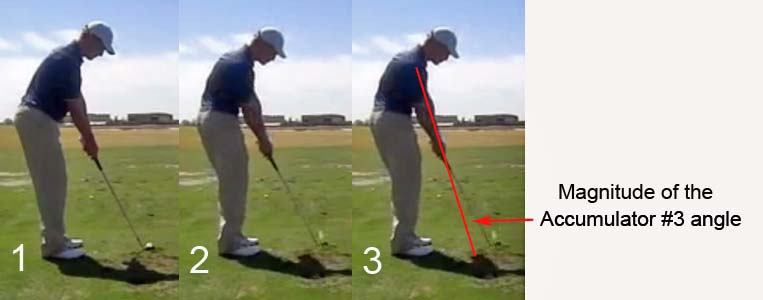
Image 1 shows Bryson DeChambeau at address, image 2 shows Bryson DeChambeau at
impact, and image 3 shows how one can measure the magnitude of the accumulator #3 angle at impact.
The accumulator #3 angle is actually the obtuse angle (wedge-shaped angle)
between the left arm and the clubshaft on the left thumb side of the club (upper
side of the club), and the magnitude of the accumulator #3 angle = 180 degrees
minus the obtuse angle. So, if the obtuse angle is close to 180 degrees, then a
golfer has a small accumulator #3 angle, and if the obtuse angle is closer to
120 degrees, then a golfer has a much larger accumulator #3 angle.
Note that Bryson's left arm and clubshaft are nearly in a straight line relationship at address and also at impact and he only has an accumulator #3 angle of ~10-13 degrees at impact. The magnitude of the accumulator #3 angle (in degrees) is equal to the angle between the red line drawn down the longitudinal axis of his left arm and his clubshaft.
The advantage of a smaller accumulator #3 angle is directly related to the "fact" that there will be less clubhead motion in space along the path of the clubhead arc for every 1 degree of supinatory roll of the left forearm during the release of PA#3, which happens between P6.5 and impact. That makes it theoretically easier for a golfer to more controllably achieve a square clubface by impact, and it is probably a major factor (in conjunction with a zero/near-zero planar shift pattern) that is causally responsible for Moe Norman's legendary ball flight accuracy.
Regarding the "security" of the grip in the left hand at the end-backswing position, I know of no reason why a mid-palmar grip pattern should be less secure than a a low palmar grip pattern - especially if a golfer uses custom-fitted Jumbo XL grips like Bryson DeChambeau.
Finally, it appears to me that the major reason why Brandel Chamblee prefers a slightly strong left hand grip (where the left thumb is placed at the 1:30 o'clock position on the aft side of the club) is based on his "belief" that it will likely position the left thumb under the handle of the club at the end-backswing position, and he believes that an under-the-club position of the left thumb will optimally support the weight of the club at the end-backswing position. Consider what Brandel Chamblee wrote in his book [1] when he stated-: "If one takes up the grip too much in the palm or with the thumb straight down the club, at the top of the swing the hand and thumb will likely not be in position to support the weight of the club and the stress of the transition." I personally think that it is a mistake to believe that the weight of the club should be primarily supported by the left thumb at the end-backswing position, because I think that the RFFW (right forearm flying wedge) should be correctly positioned at the end-backswing position in order to support the weight of the club at the end-backswing position.
Consider this composite image of Tiger Woods and Adam Scott at their end-backswing position.
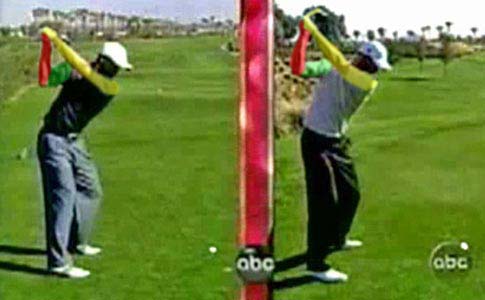
Note that both Tiger Woods and Adam Scott have an intact LAFW (colored in yellow where the left arm and clubshaft have a straight-in-line alignment) and note that their intact LAFW/GFLW is parallel to the inclined plane. The RFFW (consisting of the right forearm and bent right wrist) is colored in red, and it is optimally positioned so that the right palm is parallel to the GFLW, which is itself positioned parallel to the inclined plane. The right palm is supporting the weight of the intact LAFW, and therefore the weight of the club, at the end-backswing position, and it doesn't really matter whether the left thumb is located precisely under the shaft (rather than being positioned to the side of the shaft).
Consider this capture image of Dustin Johnson at his end-backswing position.

Note that Dustin Johnson has a markedly bowed/arched left wrist at his
end-backswing position, which means that his left thumb cannot possibly be
located under the club at his end-backswing position. That "fact" doesn't matter
because his RFFW is optimally positioned so that his right palm is parallel to
the undersurface of his club, and his club's weight is being perfectly supported
by his optimally positioned RFFW.
In summary, I agree with Brandel Chamblee that a neutral-to-slightly strong left hand grip, using a low palmar grip pattern, is a very suitable choice for a golfer's left hand, but I am not as rigid as Brandel Chamblee and I believe that it is also perfectly accptable for a golfer to use a weak left hand grip (like Ben Hogan) or a very strong left hand grip (like Zach Johnson, Ryan Palmer, and David Duval). I also think that even though it is true that many professional golfers prefer to use a low palmar grip pattern, that it is very acceptable to use either a mid-palmar grip pattern (which offers better clubshaft control at the expense of wrist mobility) or a finger grip pattern (which offers more wrist mobility at the expense of clubshaft control).
I will not discuss issues related to the right hand grip because there is nothing controversial about Brandel Chamblee's opinions on the choice of a right hand grip pattern. He, like me, believes that the right hand grip pattern should be neutral (and not weak or very strong).
Chapter 2 - The Setup
Stance width
Brandel Chamblee prefers a slightly wide stance for a driver swing where the stance width is slightly wider than the width of the shoulders, and he uses these images of Tiger Woods and Ben Hogan to make his point.
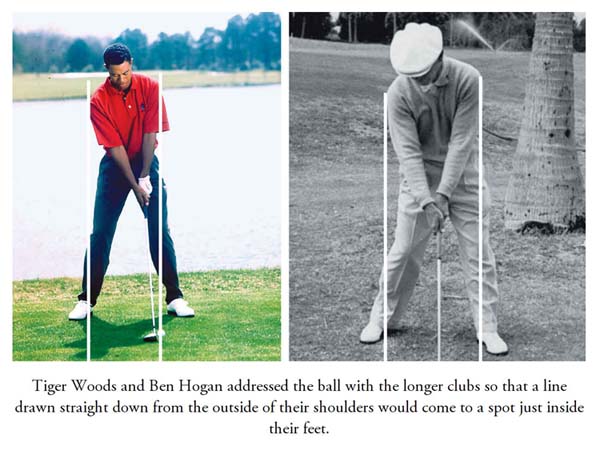
Image copied from an image in reference number [1]
Brandel Chamblee states this stance width choice offers a good balance between
pelvic mobility versus stability, and I agree with his reasoning.
I also agree with Brandel Chamblee that it is very natural for the stance width to narrow when a golfer uses shorter irons.
Right knee
Brandel Chamblee made the following comment in his book [1]-: "Almost every great player kicked the right knee in to start the swing. Some, such as Gary Player and Mickey Wright, did it in a more pronounced fashion than others, but this kicking in of the right knee is one of the most important aspects in initiating the correct sequence of many movements that follow." I disagree 100% with his opinion that an active/dynamic "kicking in motion of the right knee" is a very important biomechanical element at the start of the backswing, and I regard it as an acceptable personal choice, that should not be deemed to be mandatory. Brandel Chamblee provided no sound explanatory reasoning to bolster his personal choice of an active/dynamic "kicking in motion of the right knee" at the start of the backswing, and I believe that each individual golfer should personally decide whether it offers him any benefit. I believe that it is an idiosyncratic personal choice - like choosing whether or not to waggle the club just prior to initiating the takeaway.
Brandel Chamblee also believes that a golfer should setup with his right knee statically angled inwards at address, and he uses Ben Hogan as an example. Here are the comments that Brandel Chamblee made in his book [1] regarding Ben Hogan-: "One of the more interesting changes to Ben Hogan’s setup through the 1930s, ’40s, and ’50s, as he changed his swing to turn himself from a hooker to a fader, was the degree to which he inclined his right knee toward the target at address to use it as a trigger to begin the takeaway. This subtle change had profound effects with regard to the firing of his right leg in the downswing, specifically that he was able to “unweight” the right foot, which is to say his right heel came off the ground as the club approached hip high, and this contributed to the proper sequencing of the unwinding of his body and, I don’t believe coincidentally, greater success with each passing decade." I have no objection to Ben Hogan's personal choice to statically incline his right knee slightly inwards at address, but I think that Brandel Chamblee's explanatory biomechanical reasoning is irrational. Brandel Chamblee claims that it enabled Ben Hogan to better "fire" his right leg in the early downswing and that it helped him to properly sequence the subsequent unwinding of his body. I personally do not believe that Ben Hogan actively "fired" his right leg and "unweighted" his right foot in order to start the downswing's kinematic sequence with a pelvic rotary motion (which Ben Hogan called a "left hip clearing" type of pelvic motion) and I believe that Ben Hogan started his downswing's pelvic rotary motion by *activating his right-sided lateral pelvic rotator muscles that caused his pelvis to rotate counterclockwise away from his weight-pressure loaded right leg/foot while simultaneously activating his left-sided lateral pelvic rotator muscles in order to externally rotate his left femur in his left hip joint thereby ensuring that he could achieve a state of dual-external rotation of his two femurs at the P5 position.
(* I have described the biomechanics of an optimal pelvic rotary motion in great detail in my review paper called "Critical Update: How to Optimally Rotate the Pelvis During the Downswing")
Brandel Chamblee also argued in his book [1] that actively "kicking in" the right knee and elevating the right heel helps a golfer to straighten the left leg and elevate the left side of the pelvis in the later downswing, but I don't understand the unexplained nature of the biomechanics that could possibly undergird his proposed/theoretical causal connection. I believe that the *left leg straightens, and that the *left side of the pelvis elevates, in the mid-late downswing due to the muscular activation of the left knee extensor muscles in the anterior compartment of the left thigh and due to activation of the left gluteus maximus muscle and I believe that they are being activated while the golfer (who is a front-foot golfer) is increasingly weight-pressure loading, and thereby bracing, his left leg. I do not believe that i) any kicking in motion of the right knee and ii) any lifting of the right heel motion plays any role in this left-sided swing action.
(* I have described the biomechanics of this biomechanical phenomenon in great detail in my review paper called "Critical Update: How to Optimally Rotate the Pelvis During the Downswing")
Brandel Chamblee provided another line of reasoning to bolster his recommendation that a golfer should incline his right knee inwards at address, and he stated in his book [1]-: "That both Hogan and Nicklaus wrote about this often-overlooked key is no surprise, given that both great players are linked through a lineage of influences that traces its way back to Alex Morrison, (we already know) who wrote at great length about the need to start the swing with the right knee kicked in to initiate the motion of the swing. Morrison believed that kicking the right knee in as little as two inches at address would compensate for a slight lateral shift— a corresponding two inches— off the ball without the weight tipping over to the outside of the right foot. The weight shift would lead to a low takeaway, giving width to the swing, while also giving the player a brace to start the downswing. All of this would be achieved by the simple act of feeling a little pressure on the inside part of the right foot to begin the backswing, something we see far too little of in professional golf today, where many look like their lower bodies have been carved in stone prior to initiating the takeaway." This line of reasoning makes more sense to me, because having the right knee slightly kicked-in at address, and therefore at the start of the backswing, may help a golfer to better brace the right leg/knee during the backswing and it may thereby help (if it is associated with increased weight-pressure loading of the right leg/foot) the golfer to prevent lateral swaying of the pelvis (or right upper thigh) away from the target during the backswing action, and it also helps to prevent transfer of weight-pressure too far to the outside of the right foot. I therefore would also encourage golfers to consider the advisability of adopting Ben Hogan's reverse-K look (which involves a small degree of right knee inwards-inclination) at address as an optional choice - as depicted in the following artist-drawn image of a reverse-K address posture.
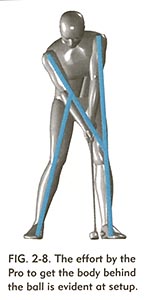
Image copied from reference number [2]
That image shows that the right knee is definitely inwards-inclined at address,
and I think that it is a perfectly acceptable address position.
However, I think that it it is also perfectly acceptable to stand with the knees more symmetrically aligned at address - as seen in this next image of Nick Faldo at address.
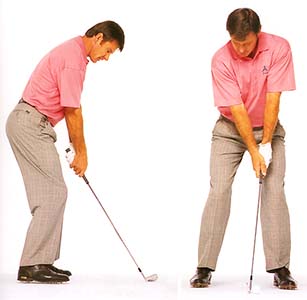
Image copied from reference number [3]
Nick Faldo's knees look more symmetrically aligned at address, but that doesn't
prevent him from weight-pressure loading and bracing his right leg/knee in an
optimal manner during his backswing action, and I do not perceive that he is standing as if his
lower body has been "carved in stone" at the initiation of his takeaway.
Consider Jordan Spieth (image 1) and Jason Day (image 2) at address when swinging a driver.

Capture images derived from swing videos
Note that both golfers do not have their right knee
inwards-inclined at address. Brandel Chamblee may perceive their lower body as
being "carved in stone" at the start of their takeaway, but I think that they
have a perfectly acceptable address posture at the start of their takeaway. I
think that having both knees symmetrically facing slightly outwards at address
is an optional choice, which can work just as well as the alternative optional choice of having one's
right knee statically inclined inwards at address. I think that
each individual golfer should feel free to experiment in order to decide which
optional choice works best for him.
Ball position
In his book [1] Brandel Chamblee stated that the SLAP authors [2] noted that most professional golfers position their ball well forward in their stance with no more than 3" between the position of the ball when using a driver relative to their ball position when using a short iron (where the ball is still positioned ahead of the middle of the stance). Brandel Chamblee states that it encourages a better forward motion of the body during the downswing (without having to move the head and body ahead of the ball by impact) and an optimum clubhead path. I agree with Brandel Chamblee regarding his opinions on the optimum ball position.
Chapter 3 - Posture
Brandel Chamblee states that the knees should be slightly bent at address so that the knees are directly over the shoelaces. I agree with his opinion and I think that a line drawn vertically downwards from directly in front of the knee cap should strike the ground approximately between the forefoot and midfoot (as demonstrated in the following image).
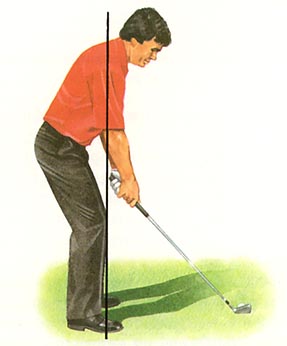
Image copied from reference number [4]
Note that the vertical black line passes just in front of the shoelaces, which means that the knees are positioned over the shoelaces. I think that the most important issue is that the knees should "feel" lively and that the golfer's weight should be equally be distributed over the forefoot relative to the hindfoot. A golfer should not "feel" that he is falling forward over his toes, or backwards towards his heels, at address.
Regarding spinal posture, Brandel Chamblee stated in his book [1] -: "If there is one area that has the most commonality among those who won the biggest events in golf, it is in the neutral or slightly concave position of the lower back and the curved position of the upper back at address. This is what they did." It may be true that those "great golfers who won the biggest events" manifested Brandel Chamblee's "desired" spinal posture, but so did most of their fellow competitors, who did not win any competitions. I think that's a very weak way of arguing on behalf of the "supposed" merits of any particular spinal posture. I think that a golfer should consider Brandel Chamblee's recommended type of spinal posture as being meritorious because it can be shown to be biomechanically natural/comfortable.
Consider the following image of Nick Faldo.
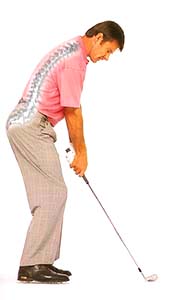
Image copied from reference number [3]
Note that I have altered that copied image by superimposing an image of the
spine over Nick Faldo's image (using Photoshop). Note that the human spine
normally/naturally has a small degree of lumbar lordosis and thoracic kyphosis
when a person stands erect, and I believe that it is natural and biomechanically
comfortable for a professional golfer to maintain that same spinal posture when
bending over at the level of the hip joints (and not at the level of the waist)
when he adopts his desired spinal bend inclination angle.
Brandel Chamblee is rigidly opposed to any straightening of the thoracic spine, and he wrote in his book [1]-: "Keeping the upper back straight and not rounded at address is a common point of modern instruction, and a glance up and down any range at a Tour event will show player after player with ramrod-straight backs. This might be aesthetically appealing, but I believe it’s a case of overcorrection, also known as hypercorrection. When trying to keep the upper part of the back straight, very often the lower part of the back becomes excessively concave. This tug of war to pull the spine straight creates far too much tension and makes it nearly impossible to get the fluidity that one seeks at the start of the backswing to say nothing of the truncating effect it has later in the swing." I agree with Brandel Chamblee that adopting a ramrod straight upper back at address may potentially create too much tension, but I do not think that a non-stiff straightening of the upper back (as manifested by many tour professional golfers) creates any unnatural tension that will hamper their swing action.
Consider the straightening of the upper back seen in these four PGA tour professional golfers.

Image 1 = Charles Schwartzel; image 2 = Adam Scott; image 3 = Jason Day and
image 4 = Michelle Wie.
I copied the images of Charles Schwartzel and Adam Scott from Brandel Chamblee's book [1] because he used them as examples of golfers whose backs are too straight (from his personal perspective), and I have added another two examples (Jason Day and Michele Wie) who have the same "straight back" look. I personally do not believe that they have ramrod straight backs, which is associated with an inordinate amount of muscular tension, and I regard their spinal posture as being perfectly acceptable because I think that it is perfectly natural/comfortable for them to acquire their "straight back" posture without any unnatural tension. From my personal perspective, I am only opposed to a ramrod straight back address posture that is "artificially" dependent on an excessive amount of muscular tension.
Distance from the ball
Brandel Chamblee states in his book [1]-: "Jack Nicklaus said that in taking his setup if an imaginary line were drawn from the top of his shoulders to the ball the left arm and club would dip slightly beneath this line and he liked to have a slight bend at the elbows. Almost every great player has had this look, where their hands hang just outside of a vertical line straight down from their shoulders, a look of freedom and comfort."
Here is a copy of the Jack Nicklaus image from Brandel Chamblee's book [1].
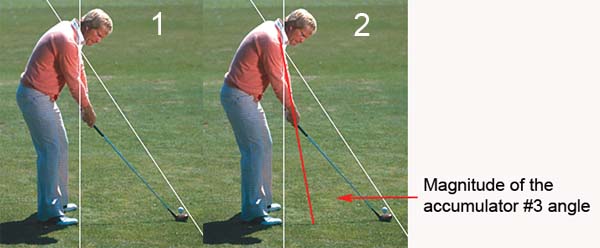
Image 1 is an unedited copy of the image of Jack Nicklaus from Brandel
Chamblee's book [1].
Jack Nicklaus has the typical "hand distance from the body" posture of a golfer who uses a low palmar left hand grip. In image 2, I have drawn a straight red line down the length of his left arm (and that red line strikes the ground closer to his feet than the ball-target line) and one can clearly see that he has a moderate-sized accumulator #3 angle.
I believe that the size of the accumulator #3 angle is very dependent on whether one uses a mid-palmar grip (like Bryson DeChambeau and Moe Norman) or a low palmar grip (like Jack Nicklaus) and the left hand grip pattern has a major effect on the distance of the hands from the body at address - presuming that one has a neutral left wrist (in the plane of radial => ulnar deviation) at address and that one doesn't have a marked "artificial" tendency to radially or ulnarly deviate the left wrist to an inordinate degree at address.
Brandel Chamblee made the following comments in his book [1]-: "I will say though that I think history has favored those who stand closer to the ball and I don’t think it is a coincidence. Those who stretched a little to get to the ball were some of the great practicers of all time, men such as Ben Hogan, Gary Player, Lee Trevino, and the cultish figure of Canadian Moe Norman. Standing farther from the ball means that the club cuts more to the inside on the takeaway and comes into the ball on a shallower angle. This shallower plane line means the clubhead will feel heavier mid-backswing and this sense of added weight can cause a responsive tensing of the hands, which one could argue disrupts the flow of the swing and requires more effort and practice to overcome. This is perhaps one of the reasons why flat swingers tend to be quicker and upright swings are more rhythmical." It is obvious that having a small accumulator #3 angle (due to adopting a mid-palmar left hand grip) means that there is small angle between the left arm and the clubshaft at address and impact, but it doesn't mean that the clubshaft travels on a shallower plane, or that there is a responsive tensing of the hands, or that the swing action doesn't flow in a more rhythmical manner. I think that Brandel Chamblee's explanation is totally meritless, and I suspect that he doesn't understand how different left hand grip patterns affect the accumulator #3 angle at address and at impact.
Consider Bryson DeChambeau's golf swing action - https://www.youtube.com/watch?v=bvdY2HA9g08
Here are capture images from his swing video.

Image 1 shows Bryson DeChambeau at address. I have drawn a red line down the
length of his left arm, and that red line strikes the ground much closer to the
ball-target line - compared to the image of Jack Nicklaus at address (see the
image just above this image) - which indicates that his left arm is more
outstretched.
However, that doesn't mean that his clubshaft "cuts more to the inside during his takeaway" as Brandel Chamblee wrongly asserts - note how steep his clubshaft is at the P3 position (image 2) when it lies on the same plane as it lay at address (which is just below the TSP). Brandel Chamblee is seemingly oblivious of the "effect" that the pattern of left hand grip (mid-palmar grip pattern versus low palmar grip pattern) has on the "degree of steepness" the clubshaft will angle upwards during the backswing's left wrist upcocking action.
Image 3 shows Bryson DeChambeau at his end-backswing position with his clubshaft just below the TSP. Image 4 shows that he has a zero-plane shift action during his early-mid downswing - note that his clubshaft descends down the same plane to impact (image 5) and it doesn't come down a shallower plane.
I also think that Brandel Chamblee's "belief" that going up, and coming down, a shallower plane - as seen in Ben Hogan's and Matt Kuchar's and Rickie Fowler's backswing and downswing - causes hand tension and/or a non-rhythmical flow of the swing has no biomechanical validity.
Finally, Brandel Chamblee made the following comment about Byron Nelson in his book [1]-: "Given the benefits of standing a little closer to the ball, it is no surprise that fairly early in his career, once his swing became grooved, Byron Nelson said he could go three weeks without touching a club and it wouldn’t affect him at all. Famously during his streak of eleven wins in a row in 1945 it was said that his pre-round warmups were never more than a half dozen or a dozen shots."
I think that's a very weak argument! I could imagine that Moe Norman, who also had a very grooved swing (but whose arms were very outstretched at address), could also go "three weeks without touching a club and it wouldn't affect him at all" - although it is difficult to imagine the late Moe Norman not wanting to touch a golf club for a three week time period, considering the "fact" that he loved to swing his golf club on a daily basis.
Alignment
Brandel Chamblee made the following opening comment in the "alignment sub-section" of his book [1]-: "Perhaps one of the biggest misunderstandings about touring professionals is that they set up square to their target. This idea fits nicely with the railroad track analogy that is given, I’m sure out of convenience, to illustrate that the feet should be placed in such a manner that if a line were drawn across the toes it would be parallel to the target line, with the two imaginary lines extending off into the distance, resembling train tracks. If taken as true and applied to every club in the bag, you will likely be setting up to fail. ---- Thanks to the diagnostic equipment we have today we know that most professional golfers hit down on the ball with every club in the bag, if only slightly with the driver. I say “most” because there are a few who hit up on their drivers. As mentioned in the last chapter we know further that if the club is descending or going down, its path is going to the right of the target line. This is why most professional golfers set up with their feet open, or to the left of their target line, offsetting with the alignment of their feet the path of the club."
I think that Brandel Chamblee is wrong about his two claims - i) Claim number 1 - that most professional golfers set up with an open stance and ii) claim number 2 - that they do so because they need to offset an "in-to-out" clubhead path with an open alignment of the feet.
First of all, the degree of "in-to-out" clubhead path at impact is very small when a golfer hits his driver, fairway woods or long irons because the downward clubhead attack angle at impact is very small and only in the range of 0.5 - 2 degrees. Secondly, a skilled professional golfer could easily adjust his clubhead path by altering the angle that his left arm/clubshaft descend down to impact (relative to his body) in order to accomodate for such a small 0.5 - 2 degrees downward clubhead attack angle - without having to adopt an open stance. Thirdly, it is my distinct impression that many professional golfers only have an overtly open stance at address when hitting short irons, and I suspect that most professional golfers adopt a square stance at address when hitting longer irons or a driver.
Consider this image that Brandel Chamblee used in his book [1] to demonstrate an open stance.
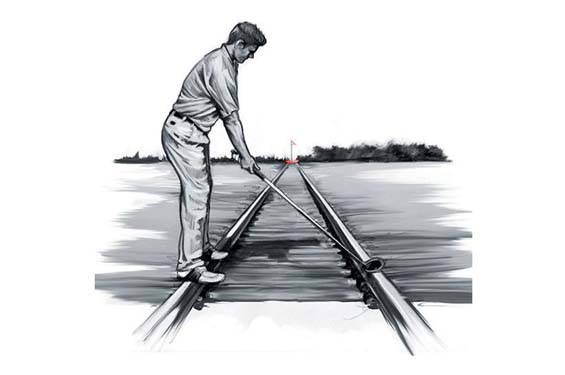
Copy of an image from Brandel Chamblee's book [1]
Note that the artist drew the feet slightly open relative to the left railroad
track - thereby implying that the foot stance is open relative to the
ball-target line.
However, Brandel Chamblee seemingly made the fundamental mistake of instructing the artist to draw the flag (target) midway between the feet and the clubhead!
Here is an edited image of the above image.
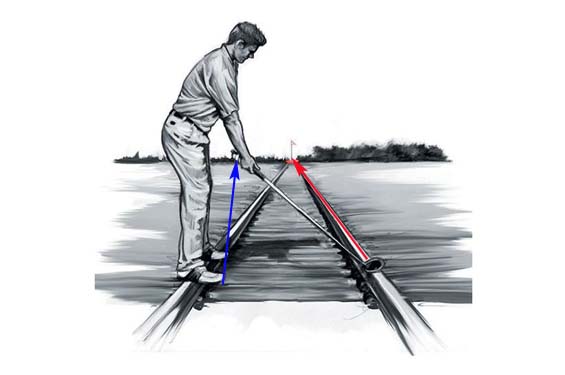
Edited image of an image that I copied from Brandel Chamblee's book [1]
I have drawn a red arrowed line between the clubhead and the flag (target) and
that line represents the ball-target line. I have drawn a blue arrowed line
across the front of both feet. Note that the blue line is closed,
and not open, relative to the red line.
I believe that the above image misrepresents "reality, and I believe that the following image better represents "reality".
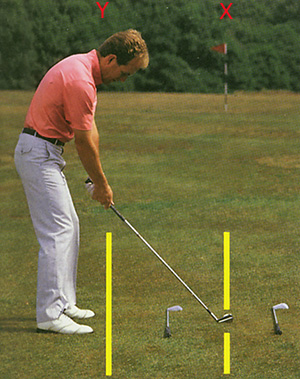
Image copied from reference number [5]
Note that the flag (target) is situated "straight-in-line" with the golfer's
clubhead, and that the yellow line drawn between his clubhead and the target
represents his ball-target line (which is parallel to the 1st golf club that is
lying on the ground). If the golfer's clubface is square relative to the yellow
line, then his clubface must be facing the target (represented by point X).
Note that the golfer's foot stance is parallel to the ball-target line and also parallel to the 2nd golf club (which is closer to his feet) and that both golf clubs are parallel relative to each other. Note that I have drawn a second yellow line in front of his feet to accurately represent his foot stance alignment and that second yellow line points at point Y, which is well left of the target. Note that both knees, both thighs, both hip joints and both shoulders are parallel to the second yellow line, which points at point Y. To the uninitiated golfer, who hasn't thought deeply about the issue of "alignment", he may get the impression that the golfer is aligned open relative to the ball-target line, but's that a wrong impression! The golfer is obviously aligning his feet/body square (parallel) relative to the ball-target line, and point Y must be well left of point X under those conditions. The absolute distance (in feet) between point X and point Y will obviously become progressively greater the further the flag (target) is from the golfer - but that doesn't mean that the golfer's alignment is open! I would recommend that you keep this important "fact" in mind when watching professional golfers on TV - when the camera is positioned down-the-line (DTL) relative to the golfer.
Spine Angle
Brandel Chamblee posted the following composite image in his book [1]
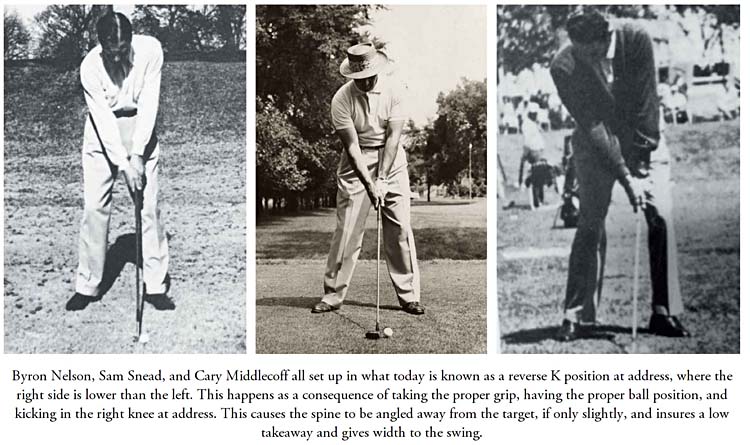
Brandel Chamblee claimed that Byron Nelson, Sam Snead and Cary Middlecoff all
had a reverse-K position setup at address where the right side is lower than the
left side and where the golfer has rightwards spinal tilt. I agree with Brandel
Chamblee that having a small degree of rightwards spinal tilt is a very suitable
spine angle at address. However, I don't agree that it is necessary to have the
right knee kicked-in at address in order to achieve that goal. There are two
ways to get rightwards spinal tilt at address. Method 1 - one
could kick-in the right knee and move the pelvis slightly targetwards so that
the pelvis is closer to to the left foot, rather than being centered between the
feet at address. That would move the lower lumbar spine targetwards and promote
rightwards spinal tilt if the head is kept stationary. Cary Middlecoff (3rd
image) is apparently using that method. Method 2 -
alternatively, one could have a more symmetrical knee position with the pelvis
more centered between the feet, but one could angle the upper torso slightly
rightwards in order to achieve a small degree of rightwards spinal tilt. Bryson
Nelson (1st image) has that "look" in the above composite image even though he "supposedly" had a reverse-K
setup with his right knee kicked-in (according to Brandel Chamblee).
Consider Jordan Spieth and Jason Day at address.

Note that they have an appropriate amount of rightwards spinal tilt - even
though they have not kicked-in the right knee.
I believe that both methods of acquiring rightwards spinal tilt at address are biomechanically acceptable.
The position of the head
Brandel Chamblee starts off with the following comment in this subsection of his book [1]-: "Almost a hundred years ago, Alex Morrison in his book A New Way to Better Golf on page 49 stated that: “You must point your chin at a spot just back of the ball and keep it pointed there until well after the ball has been hit.” He went on to say that pointing one’s chin behind the ball at address and throughout the swing was the most important single element in the correct swing and that it was not based on idiosyncrasies but on the anatomical structure of the human body. ----- Bobby Jones, having read Alex Morrison’s teachings, said, “I am convinced that this is sound, for it places the head in a position where it will not tie up the rest of the body, either on the backswing or in the act of hitting the ball.” This positioning was patently visible in Bobby Jones as he turned his head to the right as he started his backswing, almost as a trigger, and he kept it pointed well behind the ball until after impact. As did Byron Nelson, Ben Hogan, Sam Snead, and Jack Nicklaus. Jack turned his head to the right because he said Snead did it and if it was good enough for Snead it was good enough for him."
I think that Alex Morrison's comment that pointing one's chin at a spot behind the ball and keeping it pointed there until after impact is not based on the anatomical structure of the body (as he wrongheadedly claims). The true anatomical reality is that the head is exterior to the torso, and it is suspended above the rotating/pivoting torso via a very flexible cervical spine and a very rotatable atlanto-occipital joint that allows the head to easily move independently of the torso. That means that the golfer can freely decide whether to rotate the head away from the target during the backswing (which Brandel Chamblee favors) or whether to keep his head stationary. Also, he can then freely decide whether to keep his head stationary (with his chin pointing behind the ball) during his downswing and early followthrough action (which Brandel Chamblee favors) or he can swivel his head targetwards at the level of his atlanto-occipital joint (like Annika Sorenstam and David Duval). I think that all these different options are biomechanically acceptable.
Brandel Chamblee stated that Jack Nicklaus swiveled his
head slightly away from the target during his early backswing because "he
said Snead did it and if it was good enough for Snead it was good enough for
him." I think that's a very biomechanically unsound way of justifying one's
personal choice of a biomechanical swing element. Brandel Chamblee provides
another biomechanical reason in his book [1] when he states-: "This position
of the head allowed for a bigger turn of the upper body and kept passive in
transition, if only for an instant, the right side of the body and allowed the
proper sequencing of the downswing." I believe that there is zero merit to
Brandel Chamblee's biomechanical reasoning. First of all, turning one's
head/chin slightly to the right during the backswing (like Jack Nicklaus)
doesn't necessarily allow for a greater degree of upper torso rotation
if the golfer has a very flexible cervical spine, and it may only make
a significant difference in a senior golfer who has an inflexible cervical
spine. Therefore, it should be considered to be an optional swing element
choice, and not a mandatory swing element choice. Secondly, I cannot envisage
how keeping the head swiveled slightly away from the target at the start of the
transition to the downswing causes "a proper sequencing of the downswing".
The following comments in his book [1] represents Brandel Chamblee's
biomechanical explanation-: "The left side begins its target-ward move and
stretches and the right shoulder, if only for a fraction of a second, is held
back. In that fraction of a second the right shoulder drops, something I will
discuss later in this book, setting the body up for an inside to down the line
attack at the ball. This position of the head facilitates the stretch in the
shoulders in transition and adds width to the downswing." I believe that
Brandel Chamblee's biomechanical cause-and-effect reasoning - when he infers
that keeping the chin pointing behind the ball facilitates the stretch of the
shoulders and adds width to the downswing - is irrational.
Brandel Chamblee is so enamored of the idea of a golfer keeping his chin
pointing well behind the ball during the downswing that he wrote-: "In the
mid-1990s I saw sequence photos of Tiger Woods’s golf swing and in them he had
the almost identical head position of the great players. As the club approached
waist high on the downswing, his chin was still pointed well behind the ball,
the picture capturing perfectly a position common to the greatest players of all
time. I remember thinking, there is no stopping this young man." I think
that Brandel Chamblee's argument is very weak when he states that "there was
no stopping this young man" simply because Tiger Woods manifested
this single swing element that he particularly favors. What about Annika
Sorenstam who is regarded as one of the greatest female golfers in the history
of golf? Annika Sorenstam swiveled her head targetwards (in an idiosyncratic
manner) during her downswing and it didn't harm her downswing action! Why should it?
The "reality" is that both swing element options (keeping the head stationary
with the chin pointing behind the ball and swiveling the head targetwards at the
level of the atlanto-occipital joint) are
biomechanically acceptable during the downswing - because of the evolved nature
of human anatomy where the head can very easily move independently of the
rotating torso due to the existence of a very flexible cervical spine and a very
rotatable atlanto-occipital joint.
Chapter 4 - Triggering the Swing
This represents Brandel Chamblee's opinion regarding a triggering motion
at the start of the backswing action, when he wrote in his book[1]-: "Almost
without exception, going back to the earliest days of this game, the best
professional golfers have written about the importance of the movement of the
body that precedes the swing, to stave off tension. Some have waggled the club,
like Ben Hogan, who famously wrote on the subject, while others like Bobby Jones
and Lee Trevino took a few steps as they addressed the ball to kick-start their
swings. Still others like Gary Player and Mickey Wright talked of using a
forward press to initiate, as much by rebound, the beginning of the backswing.
Jack Nicklaus and Sam Snead both used a combination of the forward press of
their bodies, though it was more pronounced in Sam, and a turning of their heads
to the right to serve as a preamble to their move away from the ball.
Perhaps one of the most ruinous trends in professional and amateur golf alike is
the death of what Hogan called “the bridge” between the setup and the backswing.
As the game’s teaching has become more and more complex and microscopic in
nature, players of all abilities have become frozen in thought over the ball
and, it seems, have lost sight of the fact that the goal is to move in as big a
circle as possible, as fast as possible, as smoothly as possible— and none of
those three things can be accomplished as easily without being relaxed as the
swing begins."
I think that Brandel Chamblee's presumptious "belief" that a golfer must automatically be non-relaxed at the start of the backswing if he doesn't use a triggering motion as a "bridge" between the setup and the backswing has no scientific/biomechanical validity. Many golfers have no difficulty starting the backswing in a relaxed manner, without feeling that they are "frozen in thought over the ball", even though no they do not use a preliminary triggering motion. If a golfer performs the backswing in a more relaxed manner by first using a triggering motion, then that's a perfectly acceptable choice from my perspective, but I do not believe that a triggering motion should be deemed to be a mandatory requirement for all golfers.
Chapter 5 - The Initial Move Away From the Ball.
Brandel Chamblee prefers an one-piece takeaway where the trinity of the
shoulders, arms and hands move together as "one-piece" and where the clubhead is
kept low to the ground during the initial takeaway. I have no objection to his
general description of the one-piece takeaway, although I do not agree with his
"belief" in the value of a lagging takeaway where there is a
"feeling" of moving the hands backwards away from the target while allowing the
clubhead's backwards-motion to be momentarily delayed (which will cause a
fractional increase in the degree of left wrist bending) at the very start of
the backswing action.
Brandel Chamblee used this composite capture image of Sam Snead to portray the lagging takeaway.

Image copied from an image in reference number [1]
Brandel Chamblee commented as follows with respect to Sam Snead's takeaway
action-: "Sam Snead, with no sign of setting his wrists in his initial move
off the ball— indeed there is a hint of him leaving the clubhead behind— sets
the club on a low, wide takeaway. If this is done properly, as so many of the
greats did, there is no need to ever have to think of the path of the club at
any point on the backswing or downswing." I cannot understand how Brandel
Chamblee can rationally argue that if a golfer makes a low, wide takeaway, that
"there is no need to ever have to think of the club at any point on the
backswing or downswing". The "idea" that performing an optimum takeaway
(whatever that means) between P1 and P2 will mean that a golfer doesn't ever
have to think of his club during the remainder of the backswing (between P2 and
P4) or at any time point during the downswing (between P4 and impact) is an
oversimplistic "idea" that I find astonishing.
Note that Brandel Chamblee used the phrase "a hint of leaving the clubhead behind". What does he mean by that written description?
Brandel Chamblee offers this artist-drawn image of a person preparing to crack a whip as an analogy.

Image copied from an image in reference number [1]
In his book [1], Brandel Chamblee commented as follows regarding the above image
image-: "THE INITIAL MOVE AWAY FROM THE BALL can be likened, to some degree,
to the initial move when one is cracking a whip, where the hand moves in the
loading direction and precedes the tip of the whip. It is this feeling that one
should have to execute the movement of the loading of the club and setting it on
the right path." I can personally discern no rational reason to use this
type of lagging takeaway action, and I much prefer a takeaway action where one
creates an intact LAFW alignment as soon as possible between P1 and P1.5 - as
demonstrated by Martin Hall in one of his golf instructional videos.
Here are capture images from a Martin Hall golf
instructional video at
http://www.youtube.com/watch?v=44fev4wqC6U (which unfortunately is no longer
publically available online because of a copyright claim made by the Golf
Channel).

Martin Hall demonstrating the start of the takeaway
action
Note that Martin Hall has placed a door hinge on the back (dorsum) of his right wrist - and that hinge is placed there to emphasize the fact that the right wrist should only hinge back (dorsiflex), and not upcock (radially deviate) during the early backswing. He has also placed a door hinge on the radial side of his left wrist - and that hinge is placed there to emphasize the fact that the left wrist should only cock upwards (radially deviate) in the backswing (and never bend backwards in the plane of left wrist flexion-extension).
Image 1 shows Martin Hall at address. Note that the left wrist is significantly cupped (green angled line). The degree of cupping is greater than the amount of cupping that would exist if a golfer, who has a neutral left hand grip, had a GFLW (where the clubshaft and left arm are in a straight line alignment) at address - because the left wrist is slightly bent due to the fact that the clubshaft and left arm are not in a straight line relationship because Martin Hall prefers to hold the clubshaft roughly perpendicular to the ball-target line at address. Note that the right wrist is nearly flat (yellow anglde line).
Note what happens at the start of the takeaway - image 2. The right wrist starts to bend backwards and this biomechanical action causes the left arm and clubshaft to become aligned in a straight line relationship - and that straight line relationship constitutes an intact LAFW. Note that the bend in the left wrist disappears and a GFLW is established. From this point onwards, Martin Hall shows how a golfer should start to roll the intact LAFW (and his GFLW) onto the inclined plane. Image 3 shows Martin Hall at the end-takeaway position. Note that his left lower forearm (watchface area) and GFLW has rotated ~90 degrees from its address position and that the back of the GFLW is now roughly parallel to the ball-target line. Note that his right wrist has bent back (yellow angled line) more than it was at address.
I believe that creating an intact LAFW/GFLW alignment during the P1 => P2 time period is the optimum way to perform a takeaway action - whether one uses the one-piece takeaway action or a right forearm takeaway (RFT) action - and I will have much more to say about this "intact LAFW/GFLW" topic in the next subsection of this review paper.
Chapter 6 - The Completion of the Backswing
There are many issues to discuss in this subsection of my book
review paper, because I disagree with many of Brandel Chamblee's written
opinions as expressed in chapter 6 of his book [1].
Width
Brandel Chamblee is not only in favor of the one-piece takeaway, he is also in favor of a very wide clubhead arc during the backswing's one-piece takeaway action. Brandel Chamblee believes that a golfer should keep the clubhead as far away from the body as possible during the *P2 to P3 time period, which he believes will correlate with increased swing power. He is seemingly against the idea of setting the wrists early because he believes that it will result in a narrower clubhead arc and thereby rob a golfer of potential swing power.
(* see this review paper if you do not understand the P system of classifying a golfer's position during the full golf swing)
I believe that Brandel Chamblee is wrong because I do not believe that there is any reason to believe that there is a direct causal connection between the width of the clubhead arc during the backswing and a golfer's potential swing power. I also believe that an earlier setting of the wrists does not significantly narrow the backswing's left hand arc path, which I think is a better measure of backswing width.
Consider my argument.
Here is a copy of a composite image from Brandel Chamblee's book [1] featuring three professional golfers who use an one-piece takeaway, and who do not have an *early setting of the wrists.
(* the term "early setting of the wrists" is often used to refer to the biomechanical phenomenon of an early left wrist upcocking action).
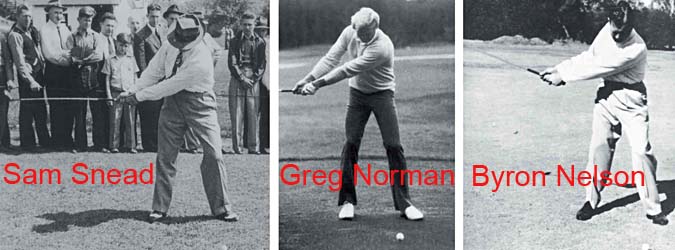
Edited copy of an image from reference number [1]
Note that all three golfers - Sam Snead, Greg Norman
and Byron Nelson - are using an one-piece takeaway while avoiding an early left
wrist setting action. Note that all three golfers are using a
rightwards-centralised backswing action and that they are all rotating their
upper torso (shoulders) perpendicularly around their rightwards tilted spine. Note that they all
have a straight left arm. In particular, note that they all have very little
bend in the right elbow, which is a characteristic biomechanical feature of an
one-piece takeaway action.
I personally have no objection to the use of an one-piece takeaway action, even though I personally prefer a *right forearm takeaway (RFT) action.
(* I have described the biomechanics of the RFT action in great detail in my backswing chapter)
I have previously used Stuart Appleby's backswing action as a prototypical example of a RFT pattern of takeaway action, and here is the composite image of Stuart Appleby's backswing action, which I previously used in my description of a RFT action.
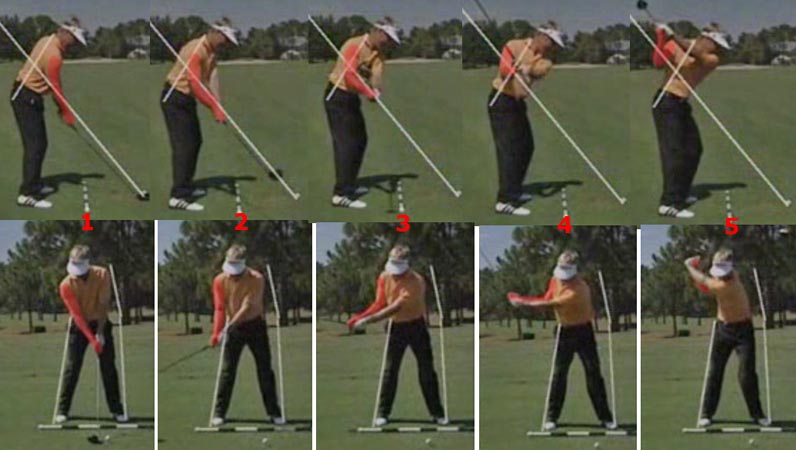
I have red-highlighted Stuart Appleby's right arm/hand, so that one can pay
particular attention to two characteristic biomechanical features of the RFT -
which is an earlier bending back of the right wrist (see image 2) and an earlier
bending of the right elbow (see image 3). Those two biomechanical features are
causally associated with an earlier setting of the wrists (left wrist upcocking
action).
To better compare Stuart Appleby to the three golfers (Sam Snead, Greg Norman and Byron Nelson), I have captured an image of Stuart Appleby at a comparable P2.5 mid-backswing position.

I have captured a face-on image and DTL image of Stuart Appleby at his P2.5
position (mid-backswing position). Because his clubshaft is not clearly visible
in the face-on image, I have drawn a thin grey line over his clubshaft to better
show its position. Note that Stuart Appleby has slightly more right elbow bend
and a greater degree of setting of the wrists - compared to those three golfers
(Sam Snead, Greg Norman and Byron Nelson) at a comparable
position. Those two biomechanical facts obviously means that his clubhead
arc will be significantly narrower. However, his biomechanical arc ( = left hand
arc) is only fractionally narrower! The biomechanical arc is a
measure of how far the left hand has moved away from the target during the
backswing action, and it is determined by i) how far the left shoulder socket has moved
away from the target + ii) how straight the left arm is during that time period
and also how much it is angled inwards. Note that Stuart Appleby also uses a
rightwards-centralised backswing action and that he has roughly the same amount
of rightwards spinal tilt as those three golfers, which
means that his left shoulder socket has moved away from the target by roughly the same
amount (presuming a similar amount of upper torso rotation at a comparable P2.5
position). Note that Stuart Appleby also keeps his left arm straight, but it is
angled slightly more inwards (away from the ball-target line) due to his greater
degree of right elbow bending action and that will fractionally narrow
his overall biomechanical arc at that mid-backswing time point.
However, I believe that it doesn't really matter because his biomechanical arc
will end up being as equivalently wide as the biomechanical arc of those three
golfers (Sam Snead, Greg Norman and Byron Nelson) at the P3 - P4 position (see
image 5 above).
To better demonstrate my claim that the biomechanical arc of a golfer who uses the combination of a "RFT takeaway + early setting of the wrists" has approximately the same biomechanical arc width in the late backswing as a golfer who uses an one-piece takeaway (like Greg Norman), I will use as an example the backswing action of a golfer - Danny Willett (2016 Masters Champion) - who has a very exaggerated "early setting of the wrists" phenomenon during his RFT action.
Capture images (from a swing video) of Danny Willett's backswing action.
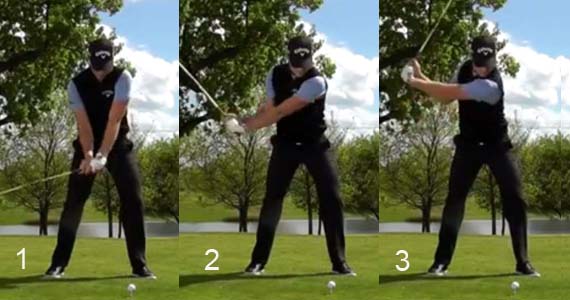
Image 1 shows that Danny Willett has a very early setting of his wrists (very
early left wrist upcocking action in the LAFW plane of radial deviation).
Image 2 is at the P2.5 position. Note that he has only a fractionally greater degree of right elbow bending than Stuart Appleby at a comparable position, which means that his biomechanical arc is fractionally narrower.
However, note how wide his biomechanical arc is at the P3 position (image 3).
To demonstrate that Danny Willett's biomechanical arc is as wide as Greg Norman's biomechanical arc at a comparable late backswing position, consider these capture images of Greg Norman's backswing action.
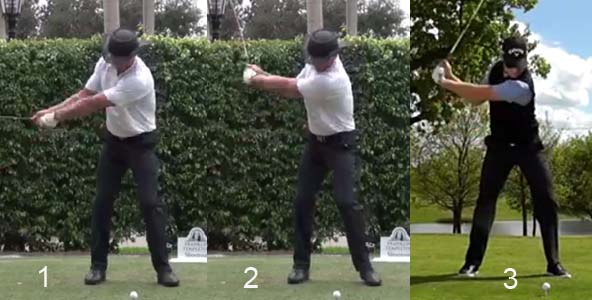
Image 1 shows that Greg Norman has a very wide clubhead arc, and a wide
biomechanical arc, at his P2.5 position and his biomechanical arc is obviously
wider than Danny Willett's biomechanical arc at a comparable position (see
image 2 above).
Image 2 shows Greg Norman at the P3 position. Note that he is now "setting his wrists", which requires a greater degree of bending of his right elbow.
Image 3 is a comparison image of Danny Willett at the same P3 position - note that his biomechanical arc is roughly similar in magnitude to Greg Norman's biomechanical arc and the difference is very small, and not really significant from a power accumulator #4 loading (left arm loading) perspective. The "fact" that Greg Norman's biomechanical arc is temporarily wider than Danny Willett's biomechanical arc between P2 and P2.5 is basically irrelevant because they both end up with a similarly wide biomechanical arc as they near their late backswing action between P3 and P4.
From a student-golfer's learning perspective, I think that if a student-golfer decides to use a RFT pattern of takeaway action (rather than the one-piece takeaway action), then he needs to ensure that he maintains the width of his biomechanical arc during the later backswing, which may require the incorporation of the TGM concept [6] known as "extensor action".
Here are capture images of the author (me) demonstrating the TGM concept [6] of "extensor action", which I described in great detail in my "How to Move the Arms, Wrists and Hands in The Golf Swing" review paper.
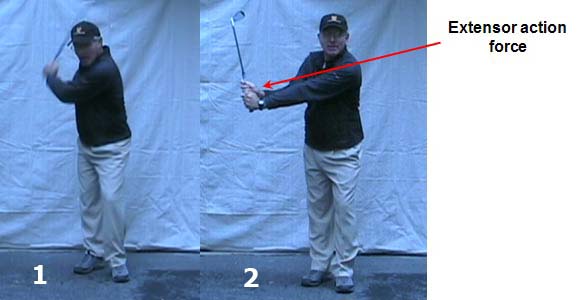
Image 1 shows the author performing a backswing action with his left arm alone.
Note the marked "bending of the left elbow" phenomenon that significantly
narrows the biomechanical arc. A student-golfer must avoid any
significant bending of the left elbow as this can significantly narrow the
biomechanical arc, which is a great disadvantage.
Image 2 shows the author using "extensor action" to help keep the left arm straight (comfortably straight, and not rigidly straight) during the entire backswing action. To apply an *extensor action force during a RFT action, a golfer must slightly extend the right elbow (even while it is bending as result of perfoming a RFT takeaway pattern of backswing action) so that the right palm can apply a small degree of push-force at PP#1 (which is located over the base of the dorsum of the left thumb) in a direction that is along the longitudinal axis of the left arm.
(* Interested readers can read this review paper if they want to better understand the biomechanics of an "extensor action" and I will not describe the complete details of this biomechanical action in this book review paper)
By the way, it is also important to realise that some golfers can very easily keep their left arm straight during their entire backswing action without applying an extensor action force, so an "extensor action" TGM-phenomenon should not be deemed to be an obligatory biomechanical phenomenon.
In summary, I believe that a golfer should optimally maximise the width of his biomechanical arc during his backswing action in order to ensure that he can maximise his swing power by loading power accumulator #4 in the optimal manner while simultaneously optimising his left arm's swing radius. However, in contrast to Brandel Chamblee, I believe that a golfer doesn't have to maximise the width of his clubhead arc in order to optimise the width of his biomechanical arc, and I believe that a golfer can generate a perfectly adequate biomechanical arc width using a RFT action combined with an early setting of the wrists (rather than an one-piece takeaway action combined with a late setting of the wrists). I would encourage each individual golfer to be open-minded about this issue, and to personally experiment, so that he can independently decide which type of takeaway action works best for him.
Clubface opening during the backswing
Brandel Chamblee not only favors the one-piece takeaway, he also favors the idea of a golfer resisting any tendency of the clubface to open during the backswing action secondary to a clockwise left forearm pronatory motion. Brandel Chamblee expressed the following comments in his book-: "As the left arm and club extend away from the target and the hands reach hip high, the right arm is above the left (if viewed from face on, the right arm is not obscured by the left) and has separated from the body. The right hand has pronated slightly (turned counterclockwise) and extended a bit (broken up toward the wrist), which puts the clubface in what has been called a shut position."
Although Brandel Chamblee focuses his mental attention on the right forearm/hand's degree of pronation in that description, I think that it is much more rational to focus one's mental attention on the degree of left forearm/hand rotary motion happening during the backswing's takeaway action - because I believe that most professional golfers are TGM swingers [6] who roll their intact LAFW onto the surface of their selected inclined plane (swingplane) by their mid-backswing.
Here is a copied image from his book [1] showing what Brandel Chamblee calls a "shut face" (closed) clubface phenomenon during the early backswing.
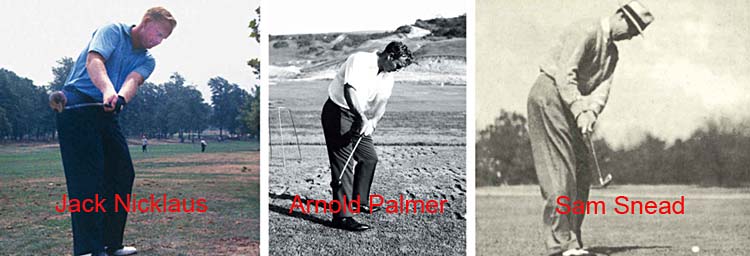
Edited image copied from an image in reference number [1]
Brandel Chamblee made the following comments regarding this composite image of
Jack Nicklaus, Arnold Palmer and Sam Snead in his book [1]-: "NOTICE THE
POSITION OF THE RIGHT HAND for Jack Nicklaus, Arnold Palmer, and Sam Snead. At
this point in the swing it is facing slightly down to the ground in what is
known as a pronated position. This is contrary to the “toe up” principle or
rotating clockwise of the right hand thought that is so often espoused as
necessary to a correct backswing. As you will see, most athletic moves, in the
loading process, have the right hand (for a right hander) facing slightly to the
ground."
Note that Brandel Chamblee is opposed to the idea of the "toe-up" principle at the end-takeaway position (P2 position), which biomechanically requires a left forearm pronatory motion to happen that will cause the left hand (GFLW) to rotate clockwise by a finite amount during the P1 => P2 time period. Why does he oppose this biomechanical action and why does he prefer what he calls a "shut face" biomechanical motion during the takeaway?
Consider Brandel Chamblee's reasoning.
Brandel Chamblee wrote the following comments in his book [1]-: "The benefits of this shut position are immense as it keeps one from rolling the arms clockwise during the backswing— which you want to do during the transition (more on this move later)— but if you do it during the backswing you will likely be too open or laid off on the downswing, something Tour pros call “getting stuck,” and you will need to flip the hands to square the clubhead." Brandel Chamblee is stating that if a golfer rolls his arms clockwise during his backswing action - by the way, it is actually the left forearm which rolls clockwise because professional/skilled golfers do not really roll their left humerus more clockwise during their backswing action - that it will cause the clubface to be too open and/or "laid-off" during the early downswing, which he seemingly equates with a greater likelihood of the golfer "getting stuck" in the mid-downswing. I regard all of his opinions as being totally wrongheaded/meritless!
I will soon express a whole series of contrary opinions, which I will arbitrarily call "facts" because I believe that I can prove all the following "facts".
i) Fact number 1 - Most professional golfers roll their left forearm clockwise in a pronatory direction between the P1 position and the P3 position to a variable degree.
ii) Fact number 2 - The degree of pronatory roll of the left forearm happening between the P1 and P3 position is inversely proportional to the strength of the left hand grip.
iii) Fact number 3 - The "toe up" position at the end-takeaway position (P2 position) where the clubface becomes parallel to the ball-target line (due to a clockwise pronatory roll of the left forearm) only happens in golfers who have a weak/neutral left hand grip.
iv) Fact number 4 - Virtually all professional golfers will have the back of their left lower forearm (watchface area) parallel to their selected inclined plane (swingplane) by the P3 position if they have an intact LAFW and if their clubshaft is "on-plane".
v) Fact number 5 - All professional golfers who manifest a "shut face" phenomenon between P1 and P2 due to temporarily resisting any clockwise rotation of their left forearm during the takeaway time period will eventually perform a clockwise pronatory roll motion of their left forearm so that the back of their left lower forearm (watchface area) becomes parallel to their selected inclined plane (swingplane) by the P3 - P3.5 position if they have an intact LAFW and if their clubshaft is "on-plane".
vi) Fact number 6 - The term being "laid off" is not causally connected to having an open clubface at the end-backswing position (due to having an appropriate amount of clockwise rotation of the left forearm happening during the backswing), but it is causally due to over-pronation of the left forearm happening during the P3.75 - P4 time period that causes the clubshaft to move "off-plane".
vii) Fact number 7 - The term "getting stuck" in the downswing is due to a number of biomechanical factors (particularly a hip spinning pelvic rotary motion +/- an excessive degree of torso-pevic separation happening during the P4 and P5.5 time period) and it has no causal connection to the degree of clubface opening happening during the backswing action.
viii) Fact number 8 - Most professional golfers do not have their right forearm in a pronatory position during their "right arm throw action" that happens in the mid-downswing between P5 and P5.5.
______________________________________________________________________________________________________
Let's start off by examining the clockwise rotation of the left forearm that I believe will naturally/automatically happen during the backswing - if a golfer i) uses an intact LAFW technique and ii) if keeps his clubshaft "on-plane" while executing the RFT pattern of backswing takeaway action.
Consider this composite image of Martin Hall demonstrating a right forearm takeaway (RFT) action.

Note that Martin Hall has placed a door hinge on the back (dorsum) of his right
wrist - and that hinge is placed there to emphasize the fact that the right
wrist should only hinge back (dorsiflex), and not upcock (radially deviate)
during the early-mid backswing. He has also placed a door hinge on the radial
side of his left wrist - and that hinge is placed there to emphasize the fact
that the left wrist should only cock upwards (radially deviate) in the backswing
(and never bend backwards in the plane of left wrist flexion-extension).
Image 1 shows Martin Hall at address. Note that the left wrist is significantly cupped (green angled line). The degree of cupping is greater than the amount of cupping that would exist if a golfer, who has a neutral left hand grip, had a GFLW (where the clubshaft and left arm are in a straight line alignment) at address - because the left wrist is slightly bent due to the fact that the clubshaft and left arm are not in a straight line relationship because Martin Hall prefers to hold the clubshaft roughly perpendicular to the ball-target line at address. Note that the right wrist is nearly flat (yellow angled line). Note that the watchface area on the back of his left lower forearm is facing the target.
Note what happens at the start of the takeaway - image 2. The right wrist starts to bend backwards and this biomechanical action causes the left arm and clubshaft to become aligned in a straight line relationship - and that straight line relationship constitutes an intact LAFW. Note that the bend in the left wrist disappears and a GFLW is established where the degree of remaining dorsiflexion that is still apparent on the back side of his left wrist is far less than it was at address. From this point onwards, Martin Hall will demonstrate how a golfer should start to roll the intact LAFW (and his GFLW) onto the inclined plane.
Image 3 shows Martin Hall at the end-takeaway position. Note that his left lower forearm (watchface area) and GFLW (which is now straight-in-line with the watchface area of his left lower forearm) has rotated ~90 degrees from its address position, and note that the back of his GFLW is now roughly parallel to the ball-target line. Note that his right wrist has bent back (yellow angled line) more than it was at address.
Now consider what happens to Martin Hall's left forearm, wrists and clubshaft as he transitions into his mid-backswing (time period between the P2 and P3 positions).

Image 1 shows Martin Hall at the end-takeaway
position (P2 position). He has an intact LAFW and GFLW and the back of his
GFLW/watchface area of his left lower forearm is vertical and parallel to the
ball-target line.
Image 2 shows Martin Hall at the P2.5 position. Note that he has continued to rotate his left forearm clockwise so that the back of his GFLW/watchface area of the left lower forearm can become parallel to his selected inclined plane (= lie on the surface of his selected inclined plane). Note that he is "setting his wrists early" while preventing any left wrist bending/bowing that would disrupt his intact LAFW's internal alignment.
Image 3 shows Martin Hall at the P3 position (mid-backswing position) where his clubshaft is positioned on his selected inclined plane (swingplane).
Image 4 shows a birds-eye viewing perspective of Martin Hall at his P3 position. Note that his straight left arm (colored in red) is straight-in-line with his clubshaft (colored in red) and together they constitute an intact LAFW. Note that he has a GFLW (represented by the yellow angled line). Note that his GFLW, and watchface area of his left lower forearm, are parallel to the inclined plane (swingplane) that he selected for his clubshaft's P3 position. Note that he must have rotated his left forearm more clockwise between his P2 position and his P3 position and that the "appropriate amount" of left forearm needed depends on the degree of steepness of his selected inclined plane. If a golfer selects a shallower inclined plane (swingplane) then the degree of clockwise rotation of the left forearm must naturally/automatically be greater, and if he selects a steeper inclined plane (swingplane) then the degree of clockwise rotation of his left forearm will naturally/automatically be less. The right forearm and bent right wrist are colored in green, and they represent the right forearm flying wedge (RFFW) which supports the intact LAFW on the inclined plane (swingplane). Note that the right elbow bends to allow the right palm to more easily become parallel to the undersurface of the inclined plane (swingplane) and to allow for a biomechanically easier "early setting of the wrists".
While Martin Hall is performing his RFT action using an intact LAFW technique, where he rolls his intact LAFW clockwise onto his selected inclined plane (swingplane), he is also following the TGM principle [6] of *tracing a straight plane line (SPL), which is the TGM technique used to keep the clubshaft "on-plane" during the entire backswing action.
(* I have described the TGM technique of tracing a SPL in this review paper)
Here is a link to the Smartstick video showing Martin Hall tracing a SPL with a Smartstick that has laser lights at both ends of the Smartstick - https://www.youtube.com/watch?v=a5rYpfmAwo4
Here are capture images from the Smartstick video.
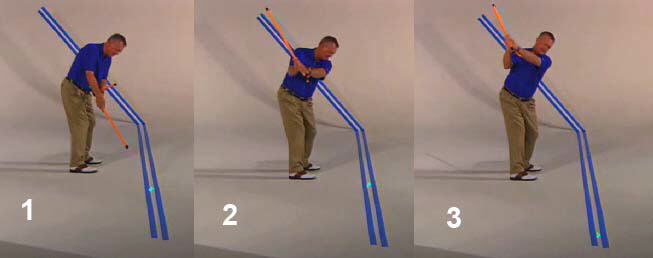
Martin Hall is demonstrating how it is possible to keep the clubshaft "on-plane"
throughout the entire backswing from P1 => P4 via the TGM
technique of tracing a SPL (where the laser light at the end of the Smartstick
that is nearest to the ground always points at the ball-target line - note that
the turquoise-colored laser light dot image is always located between the two
blue lines on the ground, and those two blue lines on the ground represent the
ball-target line).
Note that Martin Hall is at the P1.5 position in image 1 and he still has to rotate his left forearm more clockwise so that he can still remain "on-plane" when he positions his clubshaft onto his selected inclined plane (swingplane) by his P3 position (image 2). If Martin Hall used too much left forearm rotation during this mid-backswing time period, then his clubshaft would become too horizontal and the laserlight's dot image would hit the ground outside the ball-target line, thereby signifying an undesirable "off-plane" motion of the clubshaft.
Image 3 is at Martin Hall's P3.75 position - note that his clubshaft is still "on plane" and that he must have still continued to rotate his left forearm clockwise by a finite amount to keep his clubshaft "on-plane".
I believe that many professional golfers use this backswing technique (demonstrated by Martin Hall) where they maintain an intact LAFW and where they keep the clubshaft continuously "on-plane" during their entire backswing action. I will provide 4 professional golfer examples - featuring i) Gary Woodland, ii) Adam Scott, iii) Justin Rose and iv) Jason Day.
Gary Woodland swing video - https://www.youtube.com/watch?v=l1KSnwqLgec
Here are capture images from the swing video.
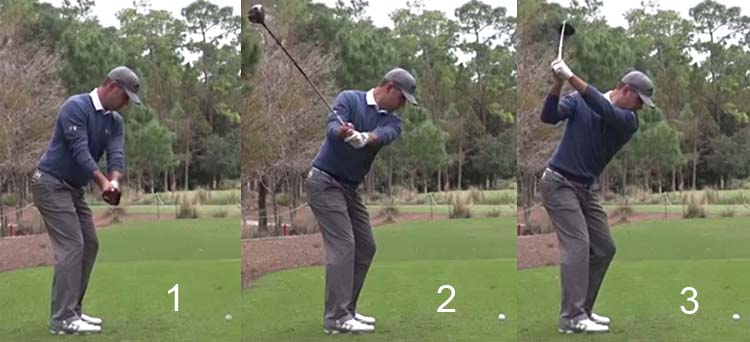
Image 1 shows Gary Woodland at his end-takeaway position. Note that he has an
intact LAFW (left arm and clubshaft are straight-in-line) and that his GFLW is
vertical and parallel to the ball-target line. Note that the toe of his club is
pointing straight-up and that he must have pronated his left forearm clockwise
by a finite amount to get to that "toe-up" P2 position.
Image 2 is at the P3 position, where his clubshaft is lying against the surface of his selected inclined plane (swingplane), and where the clubshaft is also "on-plane". Gary Woodland's left forearm must obviously have rotated more clockwise in a pronatory direction during the P2 => P3 time period to get to his P3 position.
Image 3 is at the end-backswing position (P4 position). Note that Gary Woodland's clubshaft points slightly left-of-the-target at his P4 position due to his shorter backswing action. However, he still has an intact LAFW/GFLW and he is still "on-plane". Note that his clubface is still roughly parallel to the watchface area of his left lower forearm, which is parallel to his selected inclined plane. Brandel Chamblee may assert that the clockwise rotation of Gary Woodland's left forearm, which is happening continuously between P1 => P4, is "opening" his clubface, but I believe that the amount of clubface-opening is natural/normal and fully expected, and that it is not disadvantageous or inappropriate (as Brandel Chamblee implies in his book [1]).
To better emphasise how Gary Woodland's left forearm is continuously rotating clockwise during his entire backswing action, consider the following composite image which focuses on the motion of his left forearm and GFLW.

Image 1 shows that Gary Woodland's left forearm has rotated clockwise between
the P1 and P2 positions, so that the watchface area of his left lower forearm
and the back of his GFLW can become vertical and parallel to the ball-target
line at the P2 position.
Image 2 is at the P2.25 position and image 3 is at the P2.5 position. Note how his left forearm is continuing to rotate clockwise in a smooth, non-interrupted manner while he is simultaneously upcocking his left wrist, and while he is simultaneously maintaining a GFLW and therefore an intact LAFW.
Image 4 is at the P3 position and image 5 is at the P4 position. Note how his left forearm and GFLW are continuing to rotate clockwise in a smooth, non-interrupted manner. The TGM term "educated hands" [6] is used to describe a golfer who uses a multiplicity of fundamental TGM principles to continuously control the motion of his hands, and therefore the club, in space at all moments throughout the entire swing action - and I definitely think that Gary Woodland has "educated hands".
In summary, the clockwise rotation of the left forearm happens continuously, but in a carefully controlled manner, throughout Gary Woodland's entire backswing action without generating the problem of having an abnormally open clubface at the end-backswing position, and without generating the problem of causing his clubshaft to become "laid-off" at the end-backswing position. I therefore believe that Brandel Chamblee's opinion that a clockwise rotation of the left forearm during the backswing will invariably lead to those swing faults is meritless!
Professional golfers are very skilled at controlling their rate of left forearm clockwise rotation during their backswing action, although some amateur golfers may over-rotate their left forearm during either their mid-backswing (which can cause the clubshaft to move "off-plane") or during their late backswing (which can cause the clubshaft to become "laid-off").
Consider what would happen if Gary Woodland over-rotated his left forearm during his mid-backswing.
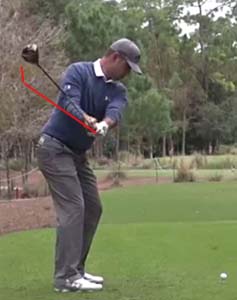
This capture image shows Gary Woodland at his mid-backswing position (P2.5
position) where his clubshaft is "on-plane" (and where a laserlight embedded in
the butt end of his club would produce a laserlight dot image that is located on
the ball-target line).
If Gary Woodland over-rotated his left forearm in a clockwise direction between P2 and P2.5, then his clubshaft would become more horizontal (see red line representing a clubshaft and clubface) and therefore "off-plane" (and where the laserlight's dot image would strike the ground outside the ball-target line). That could be deemed to represent a swing fault, which is avoidable!
Now, consider what would happen if a golfer over-rotated his left forearm in a clockwise direction during his late backswing.
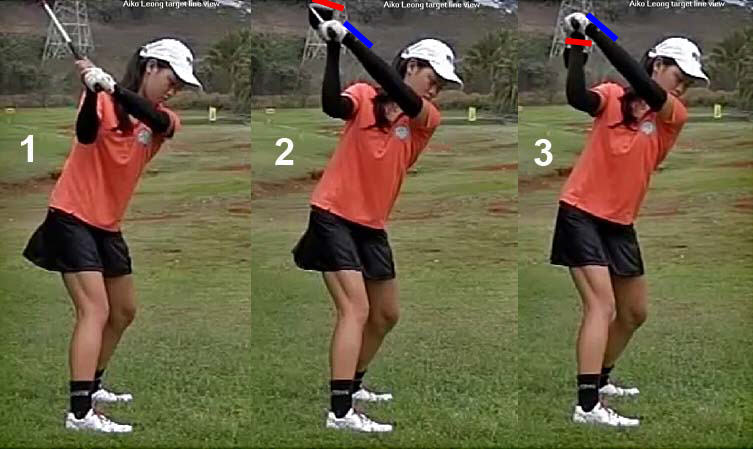
Aiko Leong's late backswing - capture images derived from a swing video
Image 1 shows Aiko Leong at her P3.5 position. Note that she has a GFLW/intact
LAFW and note that her clubshaft is likely "on-plane".
Image 2 shows Aiko Leong at her P3.8 position. She may (or may not) still be "on-plane", but one can note that her clubshaft is moving in the direction of a more horizontal "off-plane" clubshaft position. The blue line shows that the back of her GFLW and the back of her left lower forearm are still straight-line-aligned, which means that she still has an intact LFFW (which is being rotated more clockwise).
Image 3 shows how Aiko Leong's clubshaft is "laid-off" to a distinctly "off-plane" position at P4, where the clubshaft is too horizontal and where the clubface (red line) is facing too much skywards. I believe that it causally due to over-rotation of her left forearm, and not due to left wrist bowing/arching (which would disrupt the blue line showing that the back of her GFLW and the back of her left lower forearm are still straight-line-aligned). The condition of being "laid-off" could be deemed to be a swing fault, and it is avoidable!
Now, let's consider Adam Scott's backswing action by looking at capture images from a swing video ( https://www.youtube.com/watch?v=-fT3giqcHco ) .

Image 1 is at the P2 position. Note that Adam Scott has an intact LAFW/GFLW.
Note that the back of his GFLW and watchface area of his left lower forearm are
vertical and parallel to the ball-target line. Note the "toe-up" position of his
clubhead.
Image 2 is at the P3 position. Note that Adam Scott has an intact LAFW/GFLW. Note that his clubshaft is "on-plane".
Image 3 is at the P4 position. Note that Adam Scott has an intact LAFW/GFLW and "on-plane" clubshaft.
Note that Adam Scott must have continuously rotated his left forearm in a clockwise direction throughout his entire backswing - just like Gary Woodland.
Now, let's consider Justin Rose's backswing action by looking at capture images from a swing video ( https://www.youtube.com/watch?v=qNtwuX4GTpw )
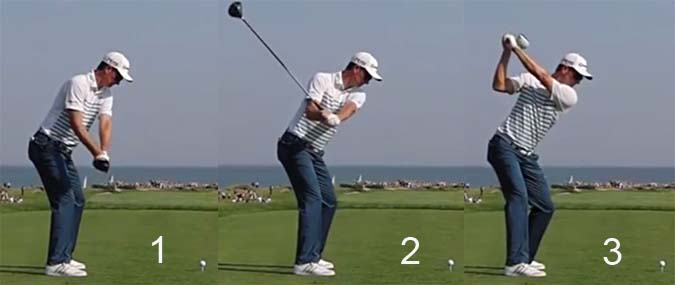
Image 1 is at the P2 position. Note that Justin Rose has an intact LAFW/GFLW. Note that the back of his GFLW and watchface area of his left lower forearm are vertical and parallel to the ball-target line. Note the "toe-up" position of his clubhead.
Image 2 is near the P3 position. Note that Justin Rose has an intact LAFW/GFLW. Note that his clubshaft is "on-plane".
Image 3 is at the P4 position. Note that Justin Rose has an intact LAFW/GFLW and "on-plane" clubshaft.
Note that Justin Rose must have continuously rotated his left forearm in a clockwise direction throughout his entire backswing - just like Gary Woodland.
Now, let's consider Jason Day's backswing action by looking at capture images from a swing video ( https://www.youtube.com/watch?v=XLn9F4zYfqM )

Image 1 shows Jason Day at the P1 position when hitting an iron.
Image 2 is at the P2 position. I have drawn a red line parallel to his clubface (which is not clearly visible). Note that Jason Day has an intact LAFW/GFLW. Note that the back of his GFLW and watchface area of his left lower forearm are vertical and parallel to the ball-target line. Note the "toe-up" position of his clubhead.
Image 3 is at the P3 position. Note that Jason Day has an intact LAFW/GFLW. Note that his clubshaft is "on-plane".
Image 4 is at the P4 position. Note that Jason Day has an intact LAFW/GFLW and "on-plane" clubshaft.
Note that Jason Day must have continuously rotated his left forearm in a clockwise direction throughout his entire backswing - just like Gary Woodland.
In summary, all 4 of those highly skilled professional golfers use the same technique where they roll their left forearm clockwise to a "toe-up" position by their end-takeaway position, and where they continue to continuously roll their left forearm (in a very controlled manner) throughout the remainder of their backswing without generating a problem of a clubface being too "open", and without becoming "laid-off", at their end-backswing position.
Now, let's consider a golfer - Greg Norman - who uses the "shut-face" type of takeaway action favored by Brandel Chamblee.
Greg Norman swing video - https://www.youtube.com/watch?v=vN3Uc_EhnnY
Capture images from the swing video.
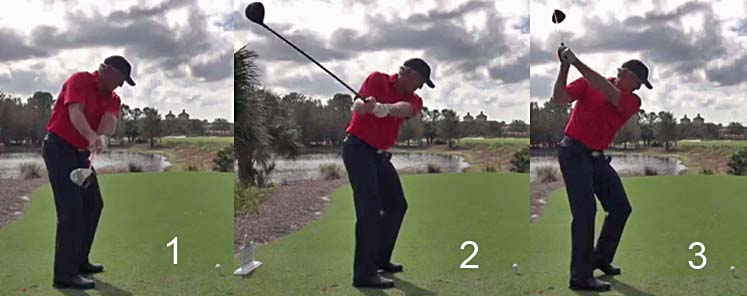
Image 1 shows Greg Norman at the P2 position. Note that he is using an one-piece
takeaway with no early "setting of the wrists". Note that he has an intact LAFW
and GFLW. Note that he is resisting a left forearm pronatory motion and that
causes his clubface to be "shut" at the P2 position.
Image 2 shows Greg Norman at his P3 position. Note that he still has an intact LAFW and GFLW and he also likely has an "on-plane" clubshaft. Note that the back of his GFLW and the watchface area of his left lower forearm is parallel to his selected inclined plane (swingplane) despite the fact that he is delaying the "setting of his wrists" - which biomechanically means that he must have rotated his left forearm clockwise roughly as much as golfers like Gary Woodland and Adam Scott.
Image 3 shows Greg Norman at his P4 position with an intact LAFW/GFLW and an "on-plane" clubshaft. Note that the back of his GFLW and the watchface area of his left lower forearm is facing skywards to roughly the same degree as those of Gary Woodland and Adam Scott and Justin Rose (who all use a similar degree of left hand grip strength), which means that he must have used approximately the same amount of left forearm clockwise rotation during his P1 => P4 time period as those three golfers. The only difference is that Greg Norman temporarily delayed his left forearm's clockwise rotation so that it mainly happens later during his mid-late backswing action.
Brandel Chamblee claimed in his book [1] that rolling the left forearm clockwise during the backswing would predispose a golfer to "getting stuck" during his downswing action. I strongly disagree with his opinion, but before I discuss that particular issue, I would like to first discuss the effect of adopting a stronger left hand grip with respect to i) the amount of clockwise roll of the left forearm that will happen between P1 and P4, and ii) its effect on the "toe-up" position of the clubhead at the P2 position (presuming that the golfer's GFLW is parallel to the ball-target line at the P2 position).
Consider yet again the differences between a weak, slightly strong and very strong left hand grip.

Note that I am repeating the explanatory comments that I made earlier in this
review paper in case you need a reminder of the explanatory information that I
previously provided regarding this composite image - see the explanatory
comments between the two horizontal lines.
___________________________________________________________________________
Note that I have drawn in black an imaginary golf club that is straight-in-line with my left arm in all three images, which means that the left wrist is geometrically flat (the GFLW is represented by the short red line) in all three images, and it also means that the LAFW (left arm flying wedge) is intact. The clubface faces the target in all three images (represented by the blue arrow). In image 1, I have adopted a weak (1-knuckle) left hand grip where I have placed my left thumb at the 12 o'clock position on the grip - note that the degree of cupping of the back of the left hand appears to be very small in amount. In image 2, I have pronated my left forearm more (note that the watchface over the dorsum of my left lower forearm has rotated more clockwise) before I grip the handle of the club, and that causes my left thumb to be positioned at the 1:30 o'clock position (when viewed from above) when I grip the club. That represents a slightly strong (2-3 knuckle) left hand grip. Note that my left wrist appears to be more cupped (dorsiflexed) - even though I still have a geometrically flat left wrist. In image 3, I have adopted a very strong (4+ knuckle) left hand grip by pronating my left hand even more so that my watchface is nearly parallel to the inclined plane before I grip the club, and that positions my left thumb at the 3 o'clock position (when viewed from above). Note that the ulnar border of my left hand, and not the back of my left hand, faces the target. Under those conditions, I still have a GFLW because the clubshaft is still in a straight line relationship with the left arm. Therefore, it is important to realise that the visual appearance of the back of the left wrist/hand in terms of its degree of cupping (dorsiflexion) will vary depending on left hand grip strength - when a golfer adopts a GFLW at address. Note that the clubface will only appear to be roughly parallel to the back of the GFLW/lower left forearm (watchface area) when the golfer adopts a weak left hand grip, and that it appears to be more closed relative to the back of the GFLW/left lower forearm (watchface area) when a golfer adopts a stronger left hand grip. So, for example, if a golfer adopts a slightly strong (3-knuckle) left hand grip at address, then the clubface will be closed by ~20-45 degrees (relative to the back of the GFLW/left lower forearm (watchface area) at address and if he adopts a very strong (4+ knuckle) left hand grip at address, then the clubface will be closed by ~45-60 degrees (relative to the back of the GFLW/left lower forearm (watchface area) at address. If that same golfer maintains a GLFW throughout his backswing, downswing and early followthrough action, then the clubface will always be closed relative to the back of his GFLW/left lower forearm (watchface area) by exactly the same amount if he continuously maintains an intact LAFW/GLFW alignment.
_________________________________________________________________________
If a golfer uses a weak-to-neutral left hand grip, then the amount of clockwise rotation of the left forearm that will happen between P1 and P4 will be significant in degree and far more than the amount that would be seen if a golfer adopted a stronger left hand grip. Also, the toe of the club will face upwards at the P2 position and the clubface will be vertical if a golfer has a weak left hand grip, and slightly closed if the golfer has a neutral left hand grip, presuming that the back of the GFLW is vertical at the P2 position.
Now, consider what will happen if a golfer uses a slightly strong (3-knuckle) left hand grip - see image 2 above. Remember that a golfer generally adopts a slightly strong left hand grip at address by pronating his left forearm before gripping the club so that his left thumb can be placed at the 1:30 o'clock position (as viewed from above). That means that the clubface will be closed relative to the back of his GFLW and watchface area of the left lower forearm by ~20-45 degrees (depending on the strength of the left hand grip) and that represents a condition of static clubface closure. If he maintains an intact LAFW/GFLW throughout his entire backswing, then his clubface will always be closed by the same amount (relative to the back of his GLFW and watchface area of his left lower forearm).
Consider an example of a golfer who uses a moderately strong left hand grip - Keegan Bradley.
Capture images from a Keegan Bradley swing video.
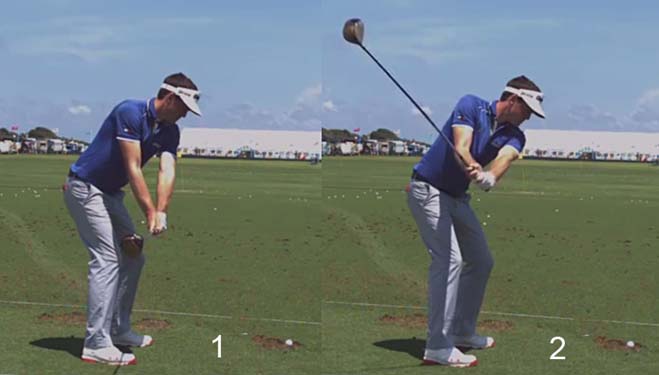
Image 1 shows Keegan Bradley at the P2 position. Note that he has an intact LAFW
and GFLW. Note that the back of his GFLW and the watchface area of his left
lower forearm is vertical and parallel to the ball-target line (as seen in Gary
Woodland's GFLW, Adam Scott's GFLW, Justin Rose's GFLW and Jason Day's GFLW at
their P2 position). However,
note that his clubface is more closed at the P2 position by ~ 20-30 degrees -
because it was statically closed by that amount at address (relative to the back of his
GFLW and watchface area of his left lower forearm). In other words, a more
closed clubface at the P2 position doesn't mean that Keegan Bradley is resisting
the left forearm's clockwise rotation (like Greg Norman), which can be
considered to be a dynamic state of
closure due to deliberately limiting the degree of left forearm clockwise
rotation that will happen between P1 and P2.
Image 2 is near the P3 position. Note that he has an intact LAFW and GFLW and that his clubshaft is "on-plane". Note that his clubface is closed relative to the back of his GFLW and watchface area of his left lower forearm by the same static amount (as existed at the P1 and P2 positions). The total amount of clockwise rotation of the left forearm that happens between the P1 and P3 position must be less (compared to a golfer with a weak-to-neutral left hand grip - presuming that they both have the watchface area facing the sky at the same angle at the P3 position) because Keegan Bradley's left forearm was already slightly pronated at address.
Now, consider what happens when a golfer adopts a very strong (4+ knuckle) left hand grip - like Domenic Mazza.
Domenic Mazza swing video - http://www.youtube.com/watch?v=8kOsio_JeIo
Capture images from the swing video.

Image 1 shows Domenic Mazza at address. Note that Domenic Mazza almost fully
pronates his left forearm before gripping the club so that he
can adopt a very strong left hand grip where his thumb is placed at the 3
o'clock position on the grip (when viewed from above) and where the back of his
GFLW and watchface area of his left lower forearm are nearly parallel to the
ball-target line at address. That will result in his clubface being ~45-60 degrees
closed relative to the back of his GFLW and watchface area at address, and this
represents the condition of static clubface closure.
Image 2 shows Domenic Mazza at his P1.5 position and image 2 shows Domenic Mazza at his P2 position. Note that he doesn't have to rotate his left forearm clockwise during his takeaway action between P1 and P2 because his GFLW is already parallel to the inclined plane at address. Note that his clubface is significantly closed at the P2 position - because he still has an intact LAFW/GFLW and the amount of static clubface closure has not changed.
Image 3 is at the P3 position where he still has an intact LAFW/GFLW and where his clubshaft is "on-plane". Note that the back of his GFLW and watchface area face the sky (to roughly the same degree as seen in golfers who adopt a weak/neutral left hand grip or a slightly strong left hand grip - presuming that they all have their clubshaft on the same planar angle relative to the ground at the P3 position). However, it is important to appreciate the fact that he only had to utilise a negligible amount of additional left forearm clockwise rotation between his P1 and P3 position - because his left forearm was already almost fully pronated at address. Note that his clubface is markedly closed relative to the back of his GFLW and watchface area of his left lower forearm by the same static amount (as existed at the P1 and P2 positions).
Finally, there is another cause of dynamic clubface closure/opening that can alter the degree of clubface closure (relative to the clubhead arc) that can happen during the backswing action and that is due to either left wrist extension/cupping (which causes the clubface to become more open) or left wrist palmar flexion/bowing (which causes the clubface to become more closed) - if these dyanamic events occur during the backswing action. Under those dynamic conditions, the LAFW will obviously become non-intact and the golfer will no longer have a GFLW (functionally flat left wrist).
In summary, if you are analysing a swing video of a golfer's backswing action and if you note that the clubface is either open or closed (relative to the clubhead arc) at any time point during the backswing action, then you first need to evaluate all the possible causes (both static and dynamic) before you make a claim about the likely cause of the clubface being too open or too closed, and before you claim that it is due to a swing fault.
With that information in mind, do you think that Adam Scott's clubface is too open at his end-backswing position as a result of the fact that the toe of his club was pointing upwards at his P2 position and as a result of the "fact" that he rolled his left forearm clockwise by a significant amount during his backswing action?
Here are capture images of Adam Scott's end-backswing position (image 1) and his early-mid downswing action (images 2 and 3).
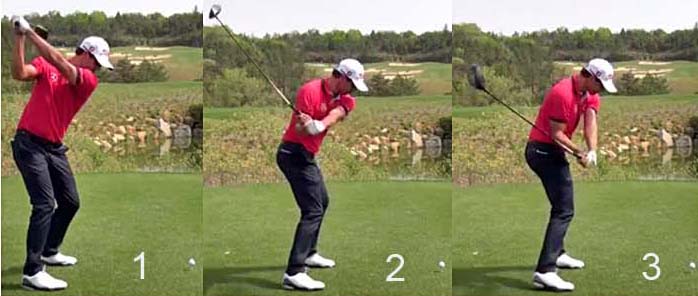
Note that his clubface can be deemed to be open during his early-mid downswing action. Is it due
to the "fact" that he rolled his left forearm clockwise during his backswing
action?
Will his open clubface cause the swing problem of "getting stuck"?
It is my opinion that Adam Scott's clubface is not really open at either his P4 position (image 1) or at his P5 position (image 2) or at his P5.5 position (image 3) - relative to his left lower forearm. I believe that his clubface is basically neutral (relative to the back of his GFLW and watchface area of his left lower forearm) and I think that it is not particularly relevant whether it is deemed to be *open relative to the ground/horizon (as a reference point) or the clubhead arc because he will be using a standard PA#3 release action to square his clubface in the later downswing between P6.5 and impact. During a standard PA#3 release action, that only happens in the late downswing, Adam Scott will have no problem squaring his clubface by impact by supinating his left forearm in a counterclockwise direction by the appropriate amount. There is no evidence that golfers (like Adam Scott) who have their clubface open relative to their clubhead arc between P4 and P5.5 - due to the fact that they rotated their left forearm clockwise during their backswing - will have to use a flipping action in order to to square their clubface by impact (as Brandel Chamblee implies in his book [1]).
(* I have explained why I never use the ground/horizon as a reference point when determining whether a clubface is open or closed at the end-backswing position in topic number 4 of this review paper)
Note that Adam Scott's clubface may "appear" to be open relative to the clubhead arc during his early-mid downswing. The reason why his clubface "appears" to be open relative to the clubhead arc is due to the fact that his left forearm, which is significantly pronated at the P4 position, doesn't become less pronated during his early-mid downswing between P4 and P5.5. In fact, his left forearm must actually be more pronated at the P5.5 position because Adam Scott progressively shallows his clubshaft between the P4 position and the P5.5 position as his hands move progressively downwards from being just above the TSP plane at P4 to being near the elbow plane by P5.5 - while he simultaneously ensures that his intact LAFW/GFLW is always parallel to his progressively shallowing clubshaft's swingplane.
Also, note that Adam Scott's right forearm must be supinated, and *not pronated, at the P5.5 position, so that he can get his right palm to be parallel to the undersurface of the clubshaft's shallow swingplane at the P5.5 position. I believe that it is not anatomically possible to have a pronated right forearm at that P5.5 time point if the right elbow is ahead of the hands in its pitch location in front of the right hip area, and if the right palm is optimally supporting the intact LAFW on its shallow inclined plane (swingplane) via the biomechanical mechanism of the right palm being parallel to the shallow inclined plane (swingplane).
(* Brandel Chamblee wrongheadedly claims that the right forearm must be pronated at the P5.5 position, but I will explain in great detail why I believe that he is fundamentally wrong in the next subsection of this review paper).
Brandel Chamblee believes that if the clubface is open to the clubhead arc due to a large amount of left forearm clockwise roll happening during the backswing, that it will cause a golfer to subsequently "get stuck" during his mid-downswing. I disagree, and I will describe the factors that I believe actually cause a golfer to "get stuck" in his mid-downswing.
The term "getting stuck" is used differently by different golf instructors/commentators, and I will explain how I personally use the term. I primarily use the term "getting stuck" to describe a biomechanical scenario where the right elbow cannot easily clear the right hip area in the mid-downswing because it is blocked by the right hip area of the pelvis. Before I describe all the factors that predispose to this particular biomechanical scenario, let's consider another common use of the term "getting stuck".
Golfers may "feel" that they are "getting stuck" if their pelvis outruns their upper torso and arms during the early-mid downswing. Golfers who are capable of generating a large amount of torso-pelvic separation (due to the "fact" that they have a large amount of lumbar spine rotary flexibility) are biomechanically more prone to develop this scenario if they over-accelerate their pelvic rotation at the start of their downswing action. If the pelvis temporarily outruns the upper torso during the early-mid downswing and the arms drop behind the rotating torso, then the golfer will "feel" that he cannot get his arms/clubshaft in front of his rotating torso without performing a flipping type of motion. I believe that this type of "getting stuck" scenario is really due to an asynchronous kinematic sequence where the pelvis is simply outrunning the upper torso from a rotary perspective, and I certainly do not believe that it is causally due to the "fact" that the golfer used a significant amount of left forearm clockwise roll motion during his backswing action (like Adam Scott).
I believe that the primary cause of a "getting stuck" scenario in a professional golfer is due to the unintentional/inadvertent use of a *hip spinning pattern of pelvic rotary motion during the early downswing, rather than the use of a pro golfer's pattern of pelvic rotary motion where the right buttocks doesn't prematurely leave the tush line during the P4 => P5 time period.
(* I have described the difference between a hip spinning pattern of pelvic rotary motion and a pro golfer's pattern of pelvic rotary motion in great detail in my "How to Optimally Rotate the Pelvis During the Downswing" review paper)
If you read that review paper, you will note that I use Adam Scott as a protypical example of a golfer who uses a pro-golfer's pattern of pelvic rotary motion between P4 and P5, and he doesn't allow his right buttocks (and therefore right hip area) to prematurely move away from his tush line between P4 and P5, and he can therefore easily get his right elbow down to its pitch location in the "space" in front of his right hip area (by actively adducting his right upper arm during the power package slotting phase) before that "space" is blocked by the right hip area of the pelvis. By contrast, a golfer who uses a hip spinning pattern of pelvic rotary motion between P4 and P5 will more likely have the "space" in front of the right hip area prematurely eliminated by a premature motion of the right buttocks (and therefore right hip area of the pelvis) away from the tush line. If a golfer, who uses a hip spinning pattern of pelvic rotary motion, also has a tendency to over-accelerate his rotary pelvic motion at the start of the downswing and develop an exaggerated degree of torso-pelvic separation at the start of his downswing, then that additional biomechanical factor will greatly increase his likelihood of experiencing a "getting stuck" problem.
A number of other factors play a secondary role regarding the possibility of a golfer having an increased likelihood of experiencing a "getting stuck" problem at the P5.5 position - and they include i) having a very assertive right upper arm adduction maneuver at the start of the downswing that assertively drives the right elbow down towards its pitch location in front of the right hip area and ii) assertively shallowing the clubshaft to a shallow swingplane by P5.5. Consider a golfer who manifests both factors - Dustin Johnson.
Capture images from a swing video of Dustin Johnson
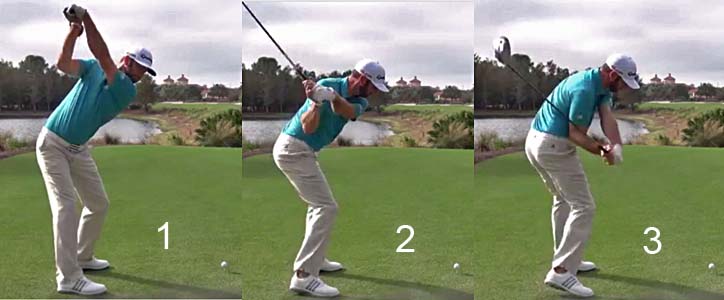
Image 1 shows Dustin Johnson at his end-backswing position. Note that he has
"high hands" due to the fact that his left arm is steeper than his shoulder turn
angle. Note that he has a very adequate degree of clockwise rotation of his pelvis despite
the fact that he keeps his left heel grounded during his backswing action.
Image 2 shows Dustin Johnson at his P5 position (end of his hip-squaring phase). Note that he has squared his pelvis by pulling his left buttocks back to the tush line, while still keeping his right buttocks approximated against the tush line. By avoiding a hip spinning pattern of pelvic rotary motion, Dustin Johnson has maintained the "space" in front of his right hip area. Note how assertively he is adducting his right upper arm, and how his right elbow is therefore much lower than his left elbow, and note that his assertive right upper arm adduction manuever enables him to assertively *shallow his clubshaft during his early downswing action.
(* I have described how professional golfers use an assertive right arm adduction maneuver to shallow their clubshaft during their early downswing in topic number 7 of this review paper)
Image 3 shows Dustin Johnson at the P5.5 position. Note how his right elbow is positioned in front of his right hip area despite the "fact" that his right pelvis has now left the tush line and rotated to a slightly open position. Note how he has markedly shallowed his clubshaft to the elbow plane via his very assertive right upper arm adduction maneuver that has driven his right elbow into its pitch location in front of his right hip area in such a manner that his "right elbow leads his hands" (as typically seen in a side-arm "stone-skipping" type of right arm throw action). Note that his right palm is parallel to the undersurface of his clubshaft's shallow inclined plane (swingplane) which biomechanically means that his right forearm must be supinated at that P5.5 time point. Note that he has a lot of right lateral bend, which is biomechanically required to get his right elbow low down to the level of his right hip area.
The fact that Dustin Johnson has a very assertive right upper arm adduction maneuver and the fact that he gets his right elbow down to a very low position by P5.5 increases his potential likelihood of "getting stuck", but it doesn't happen in his personal swing action because he avoids using a hip spinning pattern of pelvic rotary motion during his early downswing action.
Now, consider a golfer - Phil Mickelson - who has a low likelihood of "getting stuck" because he doesn't use an assertive right arm adduction manuever that asertively shallows the clubshaft in the early downswing.
Capture images from a swing video of Phil Mickelson
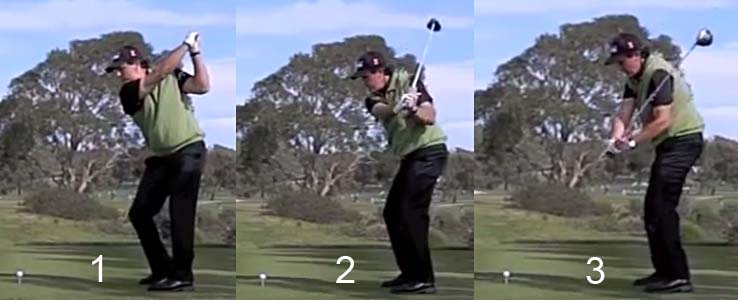
Image 1 shows Phil Mickelson at his end-backswing position. Phil Mickelson has a
well known tendency to overswing slightly, which causes his clubshaft to
cross-the-line.
Image 2 shows Phil Mickelson at his P5 position (end of the hip-squaring phase). Note that he is not adducting his rear upper arm very assertively and note that his rear elbow is not dropping well below his lead elbow (as seen in Dustin Johnson's early downswing). Note that his clubshaft is coming steeply down the TSP.
Image 3 shows Phil Mickelson at his P5.5 position. Note that his clubshaft is coming steeply down the TSP. Note that his rear elbow is well above his rear hip area, and note that he doesn't have a marked degree of lateral bend (like Dustin Johnson).
Phil Mickelson doesn't manifest a hip spinning pattern of pelvic rotary motion, but he probably still wouldn't "get stuck" if he did manifest a small degree of hip spinning pelvic motion because he doesn't assertively drive his rear elbow low down to a pitch location in front of his rear hip area by P5.5 and his rear elbow is positioned well above his rear hip area at the P5.5 position.
Finally, note that Phil Mickelson's clubface is open relative to his clubhead arc during his early-mid downswing (like Adam's Scott clubface) because he also rotated his lead forearm in a pronatory direction by a large amount during his backswing action, but that doesn't cause him to have a "getting stuck" problem (as Brandel Chamblee wrongly predicts in his book [1]).
Pelvic rotation and left heel lifting
Brandel Chamblee is unabashedly in favor of a golfer generating a very full clockwise rotation of the pelvis during the backswing and he wants it to be associated with a lifting of the left heel - as exemplified by the following 4 golfers-: Bobby Jones, Sam Snead, Jack Nicklaus and Arnold Palmer.
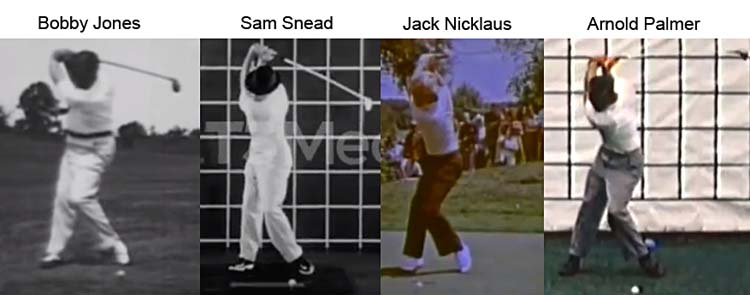
Composite image captured from multiple swing videos
Note that all 4 of those golfers have generated a large amount of clockwise
rotation of their pelvis during their backswing and they have also lifted their
left heel.
Brandel Chamblee is adamantly opposed to a golfer having a much more restricted clockwise rotation of the pelvis during the backswing - as exemplified by the following 4 modern-day golfers-: Jason Day, Jordan Spieth, Rory McIlroy and Adam Scott.
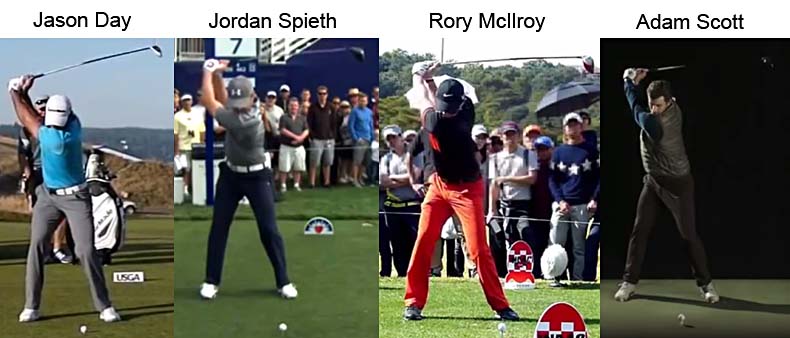
Composite image captured from multiple swing videos
Note that all 4 of those golfers have far less clockwise rotation of their
pelvis during their backswing, and they all keep their left heel solidly
grounded.
I am personally neutral regarding the question of the efficiency of these two different pelvic rotary motion patterns, and I believe that both patterns are highly efficient when it comes to efficiently rotating the pelvis counterclockwise during the early downswing's hip-squaring phase between P4 and P5. I explained why I believe that both pelvic rotary motion patterns can be highly efficient in topic number 4 of my "How to Optimally Rotate the Pelvis During the Downswing" review paper, when I described how both patterns allow a golfer to optimally load the right-sided lateral pelvic rotator muscles during the backswing, and how they can then optimally unload those muscles during the early downswing.
When I wrote that review paper, Brandel Chamblee's book [1] was not yet publically available, so I didn't have an opportunity to fully analyse the reasoning that undergirds his personal choice. In this review paper, I will more thoroughly dissect and critically analyse his reasoning.
Brandel Chamblee starts this subsection of chapter 6 by stating-: "Somewhere in the 1980s it became fashionable to maintain a lot of flex in the right knee in the backswing, the idea I suppose being that one builds tension by squatting into the right leg and that squat resists the hips’ movement which in turn allows one to build torque by turning the upper body against this resistance, like the loading of a spring we were told. The premise of this theory is so massively incorrect and its problems so numerous that for over thirty years it has almost completely divested the PGA and LPGA Tour players of their ability to build on the methods of a previous generation, not to mention their athleticism, rhythm, and health. --- To start with, the muscles and the fascia of the body do not have the same properties of a coiled spring. Regardless of how much torque or axial tension one thinks they are creating with the resistance of the lower body, there is not enough spring-like effect or automatic release of energy to offset the corresponding loss of turn. This capital crime of expository commentary has been packaged and sold to amateur and professional alike and it is pure myth. ---- When one keeps the flex in the right leg and resists with the lower body, the resistance shortens the hip turn and the amount that the torso and the shoulders turn, robbing the player of the powerful assets of time and space. Because the player doesn’t have as much time or space to create speed, there becomes an urgency to the transition and a need for explosive power to compensate. This explosive transition not only robs a player of their rhythm but because it takes a lot of effort and tension to resist the turning of the lower body, the muscles in the legs, hips, and lower back can be stressed to their limit and then are asked to accelerate to their maximum, which is the perfect recipe to cause injury, especially to the lower back and hips."
His assertion that a restricted pelvic rotation (as exemplified by the swings of Jason Day, Jordan Spieth, Rory McIlroy and Adam Scott) has divested PGA and LPGA tour golfers of their ability to build on their "athleticism, rhythm and health" is a vaguely expressed opinion that is seemingly not based on any scientific evidence or solid biomechanical reasoning, and I think that it merely reflects his personally biased opinion. I can readily agree with his criticism of Jim McLean's belief in the value of a static X factor swing that is created by deliberately restricting the pelvic rotation during the backswing so that a golfer can maximise his static degree of torso-pelvic separation during his backswing action in order to "coil" his upper torso (like a coiled spring), and I thoroughly criticised Jim McLean's X factor theory (coiling spring theory) in this review paper. However, I don't believe that modern-day professional golfers (like Adam Scott and Jason Day and Rickie Fowler) are deliberately restricting their clockwise pelvic rotation during their backswing in order to maximise their "coiling" of their upper torso. I simply think that they have so much mid-upper torso flexibility that they can achieve their desired amount of upper torso (shoulder) rotation without having to rotate their pelvis clockwise very much during their backswing action.
The second point that Brandel
Chamblee brings up is that a golfer, who restricts his clockwise pelvic rotation
during the backswing, will
have "less time or space" to create "speed" (which I presume
refers to pelvic rotary motional speed during the hip-squaring phase between P4
and P5), and that scenario therefore creates a
need for a more explosive pattern of pelvic rotary motion during the early
downswing between P4 and P5. I am somewhat sympathetic to this claim, and I
therefore believe that a "restricted clockwise pelvic rotation" loading pattern
during the backswing may not be a suitable pelvic rotary motion
loading pattern for senior golfers and physically disabled golfers who are physically incapable of generating a
sufficiently efficient contraction of their right-sided lateral pelvic rotator
muscles in order to produce a sufficiently fast
counterclockwise rotation of their pelvis away from their
weight-pressure loaded right leg at the start of their downswing. Under those
conditions of limited contractile power of the right-sided lateral pelvic
rotator muscles, it may be better for a physically handicapped golfer to get his
right hip joint deeper (further away from the ball-target line) at his
end-backswing position, and that may allow the golfer to use a greater range of
rotary pelvic motion during the early downswing's hip-squaring phase between P4
and P5 to make up for the lack of contractile power of their right-sided lateral
pelvic rotator muscles. I also suspect that golfers may experience less
explosive lumbar spine torquing forces between P4 and P5 if they use a
"non-restricted clockwise pelvic rotation" loading pattern during their
backswing followed by a slower pelvic rotary motion between P4 and P5. I
therefore think that generating a greater degree of clockwise rotation
of the pelvis during the backswing could be rationally perceived to be a more back-friendly
pelvic rotary motional loading pattern, which may be particularly relevant for
golfers who have a history of lumbar spine pathology (or who think that they may
be prone to lumbar spine pathology), although the scientific evidence - see
references [7] and [8] - to support my "back-friendly belief" is definitely not
clear-cut and free of controversy. Finally, I think that a more "non-restricted
clockwise pelvic rotation" loading pattern may be more suitable for golfers who use a reactive pivot
action, rather than an active pivot action, because they do not
actively use their right-sided lateral pelvic rotator muscles to initiate their
counterclockwise pelvic rotation at the start of the downswing, and they are
more dependent on the range-of-motion factor.
Brandel Chamblee not only prefers a greater degree of clockwise pelvic rotation
during the backswing, he also feels strongly that it must be associated with a
lifting of the left heel. In his book [1], Brandel Chamblee wrote-: "At the
top of the backswing, with few exceptions, the best players have had their right
leg extended and their hips fully turned such that their lower back or sacrum is
closer to the target than it was at address. The left knee has broken in and
points behind the ball and the left heel has risen off the ground with the
longer clubs. This last point seems to invite much scorn, even in the
increasingly scientific world of golf instruction, but none of us needs an NSF
grant to see what is in plain view. How could it possibly be bad for the average
golfer to raise his left heel when it was so important for the best golfers to
do so?"
Although I am particularly sympathetic to the idea of generating a greater amount of clockwise pelvic rotation during the backswing for a subset of golfers (as described above), I do not necessarily believe that a golfer (who is reasonably flexible) mandatorily needs to lift the left heel in order to obtain an "adequate amount of clockwise pelvic rotation" during the backswing.
Consider the end-backswing images of these 4 professional golfers - Annika Sorenstam, Dustin Johnson, Lydia Ko and Freddie Couples.
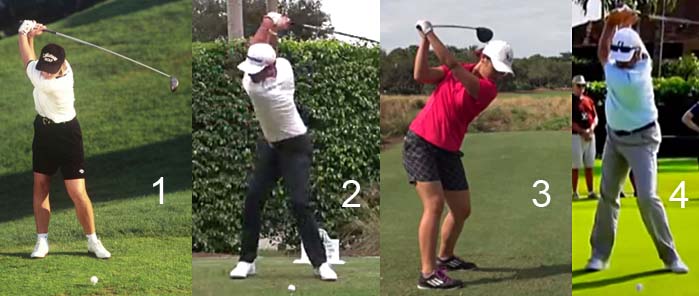
Image 1 of Annika Sorenstam was copied from reference number [1], while the
other three images are capture images derived from swing videos.
I believe that an "adequate amount of clockwise pelvic rotation" is an amount greater than 45-50 degrees, and all 4 of those professional golfers easily achieve that goal. However, note that none of those 4 golfers has to lift his/her left heel in order to achieve an "adequate amount of clockwise pelvic rotation", which is a testament to their flexibility. By contrast, if an individual golfer is insufficiently flexible, then I think that lifting the left heel in order to obtain an "adequate amount of clockwise pelvic rotation" during the backswing should be deemed to be a perfectly rational biomechanical choice.
Brandel Chamblee may object to the "fact" that Dustin Johnson and Lydia Ko still have a lot of flex in their right knee (like Jack Nicklaus), but I regard that "fact" as being biomechanically acceptable if a flexible golfer can still generate an "adequate amount of clockwise pelvic rotation". I know of no biomechanical imperative to support Brandel Chamblee's "belief" that a golfer must preferably extend the right knee joint and fully straighten the right leg during the backswing (as seen in Sam Snead's swing).
To conclude my discussion of chapter 6 of Brandel Chamblee's book [1], note that Brandel Chamblee also made the following claim in that quoted paragraph above-: "At the top of the backswing, with few exceptions, the best players have had their right leg extended and their hips fully turned such that their lower back or sacrum is closer to the target than it was at address".
Brandel Chamblee's bold-highlighted claim that the "best players had their hips fully turned such that their lower back or sacrum is closer to the target than it was at address" is obviously not true with respect to Annika Sorenstam's end-backswing position (as seen in the above composite image) although it is obviously true with respect to Jack Nicklaus' end-backswing position. Annika Sorenstam's pelvis is rotated clockwise enough so that her sacrum is facing the target at her P4 position, but it is not closer to the target because her entire pelvis has moved closer to her right foot at her end-backswing position, when it was originally centered at address.
The same "fact" applies to one of Brandel Chamblee's favorite "greatest players" - Mickey Wright - and he repeatedly refers to her swing action in his book [1].
Consider these capture images from a Mickey Wright swing video ( https://www.youtube.com/watch?v=JQhWRshs6Zs )
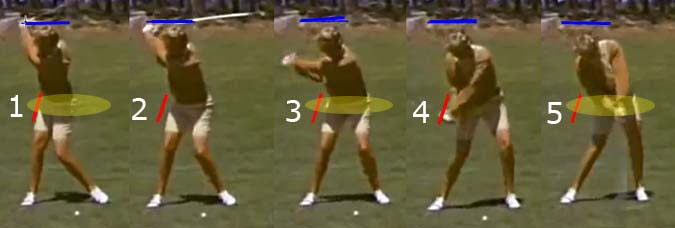
If you look at her swing video, you will note that Mickey Wright has her pelvis
centered between her feet at address.
Note that I have drawn a yellow-colored, elliptical-shaped image over Mickey Wright's capture images, and that will represent the opening of a barrel that has an opening width equal to the width of her stance.
Image 1 shows Mickey Wright at her end-backswing position. Note that she used a right-loading pelvic motion technique during her backswing action that gets her pelvis much closer to the right side of the barrel opening at her end-backswing position. That means that her sacrum has not moved closer to the target during her backswing action - even though it is facing the target secondary to the significant amount of clockwise pelvic rotation that happens during her backswing action.
By contrast, Jack Nicklaus used a left-loading pelvic motion technique during his backswing action that definitely gets his pelvis closer to his left foot at his end-backswing position. Brandel Chamblee never stated why he prefers a left-loading pelvic motion technique in his book [1[, and I personally believe that both pelvic motion loading techniques are biomechanically acceptable if they allow a golfer to optimally weight-presure load the right leg/foot at the end-backswing position, and more particularly at the exact moment of transition to the downswing.
Chapter 7 - The Transition
Brandel Chamblee believes that the transition from the backswing to the
downswing represents the critical time point in the golf swing that allows the
world's "greatest golfers" to distinguish themselves from their peers. This is
what Brandel Chamblee claimed in his book [1]-: "The upper-class of the
game’s elite, players such as Walter Hagen, Bobby Jones, Gene Sarazen, Sam
Snead, Byron Nelson, Ben Hogan, Cary Middelcoff, Peter Thomson, Gary Player,
Mickey Wright, Arnold Palmer, Jack Nicklaus, Billy Casper, Lee Trevino, Tom
Watson, Annika Sorenstam, and Tiger Woods, to the degree that they were better
than their peers, they beat them in that space between the backswing and the
downswing, where power is accumulated and stored, to be delivered an instant
later." Although Brandel Chamblee makes that bold claim, at no time point
in chapter 7 does he demonstrate that those particular golfers
do "something" during the transition that is different from their peers. He
describes many biomechanical elements that a particular "greatest golfer"
performs as he starts his early downswing, but he presents no "evidence" that
many of that golfer's peers didn't perform those same biomechanical actions.
Based on my study of the golf swings of other superb professional golfers from
the same era as those "greatest golfers", I can identify no significant
differences from a biomechanical perspective. I also think that Brandel
Chamblee's description of the biomechanics of the transitional time period is
very simplistic, and I think that it pales in comparison to my more
complex/detailed descriptions that can be found in a number of my review papers.
I will give some examples of Brandel Chamblee's descriptions in this subsection
of my review paper.
Brandel Chamblee uses Sam Snead's swing to make some points, and he used this composite image of Sam Snead in his book [1].
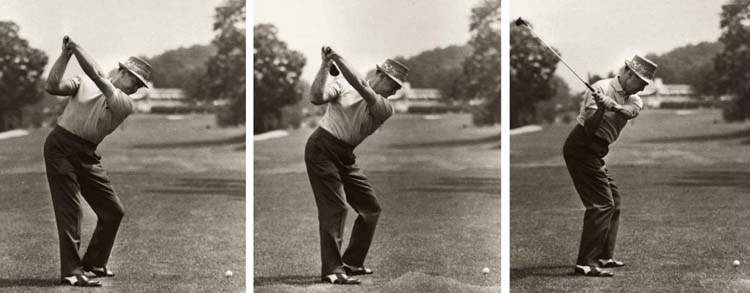
Image copied from an image in reference number [1]
Consider some comments that Brandel Chamblee made regarding Sam Snead's swing-:
"Sam Snead, with the best transition in the history of golf, arrived at the
top of his swing with an almost straight right leg and massive hip and shoulder
turn. From there he could move the left side of his body toward the target while
keeping the right side passive. This kept his left hip lower than his right and
gave him a definitive squat in the legs. --- Also clearly visible here is the
holding of the right side, resulting in the right knee kicking out in the
direction it is pointed in at the top, resulting in his famous squat, to a
lesser degree common in almost every great player. --- At this point the upper
and lower body are moving in opposite directions, something Jack Nicklaus called
the “two way stretch,” but so much more is about to happen as a consequence of
this stretch. As the body begins to rotate toward the target, the chest expands
as the left arm gets stretched and the right shoulder drops and rotates
externally or clockwise. The right knee, because of how it is pointed, say at
two o’clock on the face of a watch, kicks out in that direction and the heel
begins to come off the ground. As the left knee had a head start, the player
looks to be squatting. This squat, most visible in Sam Snead, can be seen to
some degree in almost every other great as well. This reversal of the lower body
and the simultaneous stretch and expansion of the upper body is the essence of
almost every athletic movement. This dynamic reversal of directions not only
loads the muscles, it allows for the shallowing of the club to the correct
plane."
Let's critically analyse some of Brandel Chamblee's comments.
Brandel Chamblee correctly notes that Sam Snead's right leg is straight and near-vertical at his end-backswing position, and that obviously causes his right pelvis to become higher than the left pelvis. This is a well-known biomechanical phenomenon and Robert Baker refers to that biomechanical phenomenon (where the right pelvis gets higher than the left pelvis) as a negative O factor in this video - http://www.golf.com/video/o-factor-two-wheels
Sam Snead had a significant negative O factor at his end-backswing position, but Robert Baker correctly shows that it is not essential to have a large negative O factor and that many professional golfers have a much smaller negative O factor at the P4 position. Robert Baker particularly comments on Ben Hogan's swing and he shows that Ben Hogan had a very small negative O factor at his end-backswing position and that his pelvis is almost level at the P4 position (because his right leg was much more slanted towards the target, which means that it was far less vertical than Sam Snead's right leg).
Brandel Chamblee then writes about Sam Snead's right side remaining passive while the left side of the body moves to the target, and he describes how Sam Snead's right knee kicks-out as he transitions into a squat posture (which is often referred to as Sam Snead's "sit-down" look) by the P5 position. His description is very simplistic and it contains none of complex, underlying biomechanical details that I provide in much greater detail in my "How to Optimally Rotate the Pelvis During the Downswing" review paper. Most importantly, there is zero evidence that those "greatest golfers" listed by Brandel Chamblee performed their early downswing's hip-squaring phase differently than their peers, or differently than modern-day golfers like Adam Scott, Rory McIlroy and Jason Day.
Brandel Chamblee also describes a common biomechanical phenomenon that Jack Nicklaus called a "two-way stretch", which is actually not different to the well known biomechanical phenomenon of a dynamic X factor stretch phenomenon where the pelvis starts to rotate counterclockwise in a targetwards direction while the upper torso is still rotating clockwise during the backswing. I have discussed this dynamic X factor phenomenon in great detail in topic number 4 of my "Critical Analysis of Theories/Opinions Regarding the Optimum Pelvic and Spinal Motion in the Full Golf Swing" review paper, and I have demonstrated that professional golfers vary in the amount of torso-pelvic separation (dynamic X factor) that they develop during the transitional time period, and I know of no evidence that maximising one's dynamic X factor is advantageous. Most importantly, there is no evidence that Brandel Chamblee's listed "greatest golfers" performed this biomechanical phenomenon differently to their peers, or many superb modern-day golfers.
Brandel Chamblee is adamantly opposed to restricting the pelvic rotation during the backswing action, and he made the following comments in a box called "Dangers of Resisting with the Lower Body".
Here is an unedited copy of that box from his book [1].
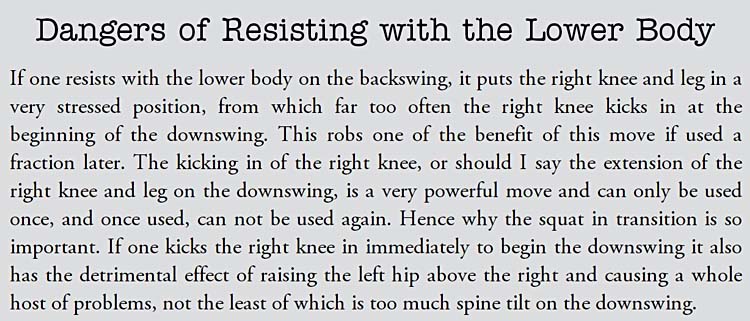
Note that Brandel Chamblee wrongheadedly claims that if a golfer restricts the
clockwise rotation of his pelvis (lower body) during the backswing, that it puts
the right knee and leg in a very stressed position, which causes the right knee
to kick-in at the beginning of the downswing. He then secondly asserts that if a
golfer kicks-in the right knee prematurely at the start of the downswing that it
robs him him of the ability to subsequently kick-in the right knee fractionally
later, which he regards as a very powerful move. I harbor a totally different
opinion! I believe that there is zero evidence to show that modern day golfers
(like Adam Scott, Rory McIlroy, Jordan Spieth and Jason Day), who restrict their
clockwise pelvic rotation during the backswing, prematurely kick-in their right
knee at the start of the downswing. More importantly, I don't think that
any "kicking-in" motion of the right knee (which usually only happens
in the mid-downswing when the pelvis starts to rotate to an open position) is a
very powerful move. In fact, I believe that any active
kicking-in motion of the right knee during the early downswing often
signifies a hip spinning pattern of pelvic rotary motion, which is very
disadvantageous because it may potentially increase the likelihood of the golfer
"getting stuck" (as previously described). Most modern-day professional golfers (like Adam Scott, Rory
McIlroy, Jordan Spieth and Jason Day) use a pro-golfer's pattern of pelvic
rotary motion to start their downswing and I believe that they do not use any
active right knee kicking-in action during their early
downswing. Also, I know of no reason why any golfer should
believe that any active kicking-in motion of the right knee at
any time point in the downswing should be perceived to be a
"powerful move" - and I have discussed this issue in great depth in my "How
to Optimally Rotate the Pelvis During the Downswing" review paper.
Brandel Chamblee then starts to describe what happens in the mid-downswing, and I think that he gets his "facts" particularly wrong when he discusses the motion of the right forearm during the P5 to P5.5 time period.
Brandel Chamblee posted this composite image of Ben Hogan in his book [1].
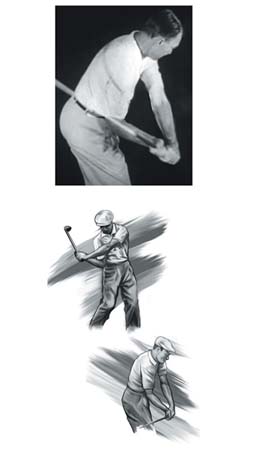
This is what Brandel Chamblee wrote in his book regarding these images-: "Ben Hogan in Five Lessons had illustrations showing what he believed to be his positions on the downswing, both in the transition and delivering the club to the ball. The middle illustration here is based on the photograph from Life Magazine where he was posing for the illustration that made its way into that famous book. If one looks at the position of his right hand you can see that he is "posing" with it pointing toward the sky but in reality as one can see from the top high speed photo Hogan's hand was nowhere near that position and was far more pronated or inclined towards the ground, which put the club in a position far different to the one he illustrated at the bottom of this page. These pictures have misled advocates for years and have led to an epidemic of people "being stuck" on the downswing".
I totally disagree with Brandel Chamblee and I think that he is misinterpreting those images. If you look at that top photo, you can see that Ben Hogan's clubshaft is on a shallow plane at the P5.5 position and that his clubshaft is nearly straight-in-line with his left arm creating an intact LAFW alignment. You can also see that the back of his left hand and watchface area of his left lower forearm is parallel to the shallow inclined plane (swingplane) on which his clubshaft is located and that his RFFW is correctly aligned relative to his LAFW so that the right palm is parallel to the undersurface of the inclined plane (swingplane). Note that Ben Hogan's right elbow is located in a pitch location in front of his right hip area and that it is ahead of his right hand - as if he were performing a side-arm (or under-arm) pitching motion with his right arm/hand. Under those biomechanical conditions, the right humerus must be externally rotated and the right forearm must be supinated - as correctly demonstrated in the middle image. The lower artist-drawn image is not at the P5.5 position, and it represents what happens to Ben Hogan's club and forearms/wrists/hands as he transitions between the P5.5 to the P6.2 position - note that the back of his left hand becomes vertical to the ground, and that his left wrist becomes bowed, and that his left forearm becomes more supinated, and that his clubshaft moves slightly underplane. Those biomechanical and clubshaft changes are due to the "fact" that Ben Hogan seemingly used the optional *combined technique of "early left forearm supination + left wrist palmar flexion" between P5.5 and P6.2, and during that process the right forearm must become slightly less supinated, but it is definitely not pronated, and the right palm is definitely not inclined towards the ground during that biomechanical process.
(* If you are interested in understanding the precise details of that combined technique, then you can read topic number 8 in this review paper).
Here are capture images of Gary Woodland's arms/hands when he uses the same combined "early left forearm supination + left wrist palmar flexion" technique between P5.5 and P6.2 in his downswing action.

Image 1 shows Gary Woodland at his end-backswing position with an intact LAFW
and GFLW.
Images 2 and 3 shows how Gary Woodland shallows his clubshaft during his early downswing while maintaining an intact LAFW/GFLW that is parallel to his shallowing inclined plane (swingplane).
Image 4 and 5 shows how Gary Woodland starts to perform the combined technique of "early left forearm supination + left wrist palmar flexion" which causes his clubshaft to move slightly under the plane (see image 5).
Now, here are close-up capture images of Gary Woodland's hands at the P5.2, P5.5 and P6 positions - from the same swing video.

Image 1 is at the P5.2 position. Note that he has an intact LAFW and a GFLW that
is parallel to his shallowing clubshaft's swingplane, and that his right palm is
also parallel to that swingplane, which means that his right forearm
must be supinated if his right elbow is alongside his right hip area.
Image 2 is at the P5.5 position. Note that he is starting to use the combined technique of "early left forearm supination + left wrist palmar flexion" and that the back of his left wrist/hand is becoming more vertical. Because his right palm remains parallel to his left palm, it is becoming more vertical and that means that his right forearm must be becoming less supinated.
Image 3 is at the P6 position. Note that the back of his left wrist/hand is now vertical, which means that his right palm must also be near-vertical. That means that his right forearm must be becoming less supinated, but it is not pronated. If his right forearm were truly pronated at that time point, then his right palm would be facing more towards the ground - but it is near-vertical and facing the ball-target line, which means that his right forearm must still be supinated (but far less supinated than it was at P5.2 - P5.5).
Why does Brandel Chamblee believe that the right forearm must be pronated during the mid-downswing so that the right palm faces more groundwards? The answer can be found in his book when you read his opinions on the way the right arm/forearm should move during the backswing and downswing.
Consider what Brandel Chamblee stated in his book regarding the backswing [1]-: "Yet time and time again I read and hear it said that one should have the clubface in a "toe-up" or "square" position when the hands reach hip high. This is why "getting stuck" is a common refrain on Tour these days. We have been told that the right palm should open up or roll clockwise in the backswing. Imagine if a quarterback or a pitcher tried to throw a ball in this way, rolling the throwing arm and hand clockwise in the loading motion. They would loose the stretch-shortening cycle of the muscles in their hand and arm in the transition, lose power and accuracy, and never be heard from again. It is the slightly shut position of the clubface that one wants when the hands are hip high and nobody did this better than Jack Nicklaus and Byron Nelson".
To emphasise his point, Brandel Chamblee posted a number of photo images of the following sport athletes.
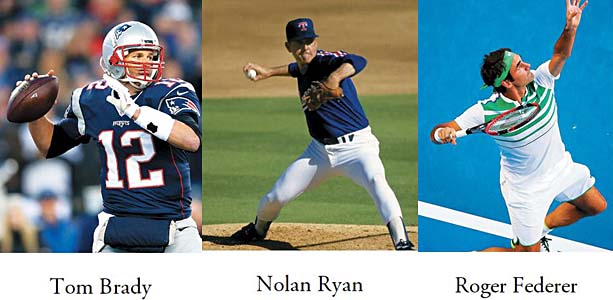
Composite image created from three images copied from reference number [1]
Brandel Chamblee then posted the following comments in a box in his book [1].

Note that Brandel Chamblee wants a golfer's right palm to face the ground during
the backswing so that it can put the "whole right arm and hand on the proper
path to deliver the club". In other words, he seemingly thinks that the
right arm/hand must operate as if a golfer was performing an overhand
throw motion with the right arm/hand during the downswing - where the right
forearm would be pronated and where the right palm would be facing groundwards.
Do you think that a professional golfer performs a right arm/hand motion in the early-mid downswing in such a manner that it can be likened to an overhand right arm throwing motion (which is a very suitable choice for the type of right arm throw motion performed by a football quarterback or a tennis player serving the ball in an overhand manner) - rather than a side-arm right arm throwing motion or an underhand right arm throwing motion?
I believe that the majority of professional golfers shallow their clubshaft during the early-mid downswing, so their RFFW has to move in either a side-arm right arm throwing motion or an underhand right arm throwing motion during the early-mid downswing if the golfer wants the right palm to optimally support the intact LAFW on the progressively shallowing inclined plane (swingplane) between P4 and P5.5.
I think that only a few professional golfers have their right palm facing more vertical, or more groundwards, during the early downswing, and they are all coming down a very steep hand arc path.
Consider an example - Steve Marino.

Capture images from a Steve Marino swing video
The red splined path represents his downswing's steep hand arc path. I have
drawn blue lines at the level of his right and left elbow joints to assess their
relative degree of downwards motion during the early-mid downswing.
Image 1 shows Steve Marino at his end-backswing position. Note how steep his left arm is angled upwards, which means that his right forearm must be near-horizontal at the P4 position if the RFFW is going to be correctly aligned with respect to his intact LAFW.
Image 2 is at the P4.5 position. Note how steeply his clubshaft descends down his steep hand arc path, which means that his right palm must be near-vertical during that time period so that it can be correctly aligned relative to his intact LAFW, which is coming down a very steep path.
I therefore think that it is relatively reasonable to consider Steve Marino's right arm/hand motion during the P4 => P4.5 time period as being more equivalent to an overhand right arm throwing motion, although it actually converts to being more equivalent to a side-arm right arm throwing motion by the P5.5 position when his clubshaft becomes much shallower than his hand arc path (image 3). If he continued to move his right arm/hand in an overhand right arm throwing manner after P4.5, then he would essentially be coming over-the-top (as frequently seen in amateur golfers who have an OTT move that predisposes to an out-to-in clubhead swingpath through impact)
However, it is relatively rare to see a professional golfer, who has very "high hands" at the P4 position, come down such a steep hand arc path during the early downswing. Most professional golfers, who have "high hands" at the P4 position (eg. Ryan Moore, Rory Sabbatinni and Jim Furyk), re-route their clubshaft in a looping manner during the early downswing so that their hands/clubshaft can descend down a less steep path during the P4.5 => P5.5 time period.
Consider an example - Ryan Moore.
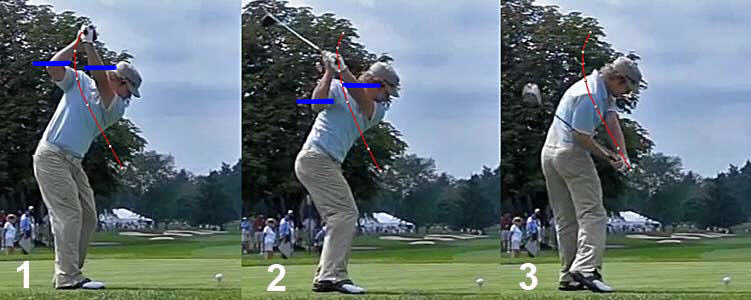
Capture images from a Ryan Moore swing video
The red splined path represents Ryan Moore's downswing's hand arc path - note
that it starts off steep between P4 (image 1) and P4.5 (image 2), but that
it becomes progressively less steep between P4.5 (image 2) and P5.5 (image 3). I
have drawn blue lines at the level of his right and left elbow joints to assess
their relative degree of downwards motion during the early-mid downswing.
Image 1 shows Ryan Moore at his end-backswing position. Note that he has "high hands" - like Steve Marino.
Image 2 is at P4.5 and image 3 is at P5.5. Note how Ryan Moore actively adducts his right upper arm so that his right elbow drops much lower than his left elbow, and that shallows his clubshaft during his early downswing action. Note how his clubshaft is on a shallow plane at the P5.5 position, and that his right arm/hand motion between P4.5 and P5.5 is more akin to that of an athlete performing a side-arm right arm throwing motion. That means that his right palm must be much more horizontal at the P5.5 position (and parallel to the shallow inclined plane on which his clubshaft is positioned), and that requires his right forearm to be supinated, and not pronated, if his "right elbow leads his hands".
Most professional golfers do not have "high hands" at their end-backswing position, and they have their hands at, or just above, the level of their right shoulder (eg. Adam Scott, Justin Rose, Tiger Woods, Jason Day and Jordan Spieth) or just below the level of their right shoulder (eg. Ben Hogan, Rickie Fowler, Matt Kuchar and Jason Duffner). All of those golfers are going to be shallowing their clubshaft during the early-mid downswing, so that their right arm/hand motion can be better likened to a side-arm right arm throwing motion, or an underhand right arm throwing motion, if their "right elbow leads their hands" - and their right forearm therefore has to be supinated, and never pronated, during the P4.5 => P5.5 time period.
Consider an example - Ben Hogan.
Ben Hogan swing video - http://www.youtube.com/watch?v=LJdChWnxDvU
Capture images from the Ben Hogan swing video.

The left arm, with the clubshaft straight-in-line, is colored in *yellow and it
represents an intact LAFW.
The right forearm and bent right wrist is *colored in red and it represents the RFFW.
The right upper arm is colored in green and it connects the RFFW to the torso at the level of the right shoulder socket.
(* ignore image 4 which was incorrectly colored at the level of the hands)
Image 1 is at the end-backswing position, where Ben Hogan's hands are just below the level of his right shoulder.
Images 2, 3, 4 and 5 show how Ben Hogan progressively shallows his clubshaft between the P4 and the P5.5 position.
If you follow the motion of his right arm/forearm/hand during his early-mid downswing, it can be likened to an athlete performing an underhand right arm throwing motion, and under the anatomical/biomechanical constraints of an underhand right arm/hand throwing motion (where the "right elbow leads the hands") the right forearm cannot possibly be in a pronated position. I think that it is patently obvious that Ben Hogan's right forearm must be supinated, and not pronated, in image 5 and that his right palm must be facing skywards.
Brandel Chamblee is adamantly opposed to the right forearm being supinated at the P5.5 position, and this is what he states in his book-: "If the right elbow moves towards the right hip and the right arm moves as if one is losing an arm wrestling match, without the right wrist turning counterclockwise, the clubface will be open and the shaft under the plane and in a very poor position to be delivered to the ball. This will require one to compensate, likely by stalling with the whole body in order flip the hands to square the club".
I find it astonishing that a golf commentator/instructor, who deems himself to be knowledgeable about golf swing biomechanics/mechanics, would make that bold-highlighted statement!
I believe that most professional golfers, who use a weak left hand grip (like Ben Hogan) or a neutral left hand grip (like Adam Scott or Henrik Stenson), will have a clubface that is open to the clubhead arc at the P5.5 position if they have an intact LAFW that is positioned on a shallow swingplane, and they certainly do not have to stall their torso's rotation and then flip their their hands in order to square the clubface by impact. Brandel Chamblee is seemingly unaware that those professional golfers can simply rotate their left forearm counterclockwise between P5.5 and impact in order to square their clubface by impact.
If you consider a professional golfer (who has a neutral left hand grip) at the P5.5 position with his clubshaft positioned on a shallow plane (eg. elbow plane) then his clubface will be open at the P5.5 position if he has an intact LAFW and GFLW that is parallel to his shallow swingplane.
Consider an example - Henrik Stenson.
Henrik Stenson swing video - http://www.youtube.com/watch?v=OKfe6F8PmUc
Here are capture images of Henrik Stenson from his swing video.
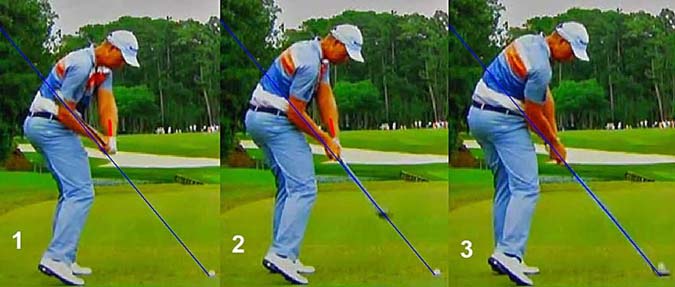
The blue line represents the elbow plane.
Image 1 is at the P5.5 position. Note that Henrik Stenson has shallowed his clubshaft down to the elbow plane by the time he reaches the P5.5 position. Note that his GFLW and right palm are both parallel to the elbow plane, which biomechanically means that his left forearm must be pronated and that his right forearm must be supinated if his right elbow is wedged in a pitch location in front of the right hip area. Note that his clubface is wide open to the clubhead arc, and parallel to the back of his GFLW. I have drawn a red line over his left radial bone just above the level of his glove.
Image 2 is at the P6.5 position. Note that his clubshaft is moving down the elbow plane, and it is not moving under-the-plane (as Brandel Chamblee wrongly predicted). Note that his left radial bone (red line) is moving counterclockwise (relative to his left antecubital fossa), which means that he is supinating his left forearm. Note that his right forearm is simultaneously moving from a supinated position towards a neutral position (but it is not yet pronated).
Image 3 is at impact. Note that Henrik Stenson's clubshaft is still on the elbow plane and it never had to move under-the-plane between the P5.5 position and impact - despite the "fact" that his clubface was wide open at the P5.5 position and despite the "fact" that his right forearm was markedly supinated at the P5.5 position. At impact, Henrik Stenson's left forearm is now much more supinated and his right forearm is now neutral, and no longer supinated.
How does Henrik Stenson perform his left forearm's supinatory motion between P5.5 and impact.
Here are two graphs from Phil Cheetham's PhD dissertation paper [9] showing how a professional golfer rotates his left forearm counterclockwise during the later downswing, and thereby squares the clubface by impact by continuously twisting the handle about its longitudinal axis.

Composite image created from copies of two graphs found in reference number [9]
The top graph is a measure of the club handle twist velocity during the
downswing. Note that the club only starts to twist counterclockwise in the later
downswing and it first starts to twist counterclockwise at the time of the twist release point. The solid
yellow color block shows the first phase where the handle twist velocity is
slow, and it then becomes much faster just prior to impact.
The bottom graph shows 3-D measurements of the left forearm's angular velocity and you can see that there is a close correlation between the angular velocity of left forearm supination (blue graph in figure 16) and the handle twist velocity (red graph in figure 17 above), thereby implying that there is a direct causal connection. Note that the left forearm's speed of supination is slow between the green arrow and the red arrow, and that represents the slow phase (phase 1) of left forearm supination. Note that the left forearm starts to rotate much faster after the vertical red arrow, and that represents the rapid phase (phase 2) of left forearm supination. Homer Kelley in his TGM book [6] called the rapid phase of left forearm supination the release of PA#3, which will be primarily responsible for squaring the clubface by impact.
It is even possible to discern these two phases of left forearm supination by examining 2-D capture images from a swing video.
Consider Henrik Stenson's slow and rapid phases of left forearm supination.
Capture images from the Henrik Stenson swing video.
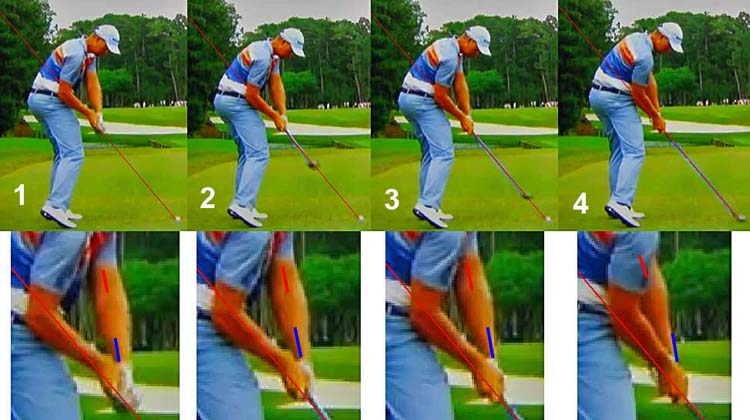
I have added a second series of capture images below images
1,2,3 and 4 that
provide a close-up view of Henrik Stenson's left forearm and hands at those 4
positions. Note that image 1 is at P6, image 2 is at P6.5, image 3 is at P6.8 and
image 4 is at impact. I have drawn a red line down the middle of his left
antecubital fossa that represents a reference point for definining pronation and
supination. I have drawn a blue line over the radial bone of his left lower
forearm just above his glove. If the blue line is to the left of the red line
(as seen from a DTL viewing perspective),
that means that his left forearm is rotated clockwise (relative to the center of
his left antecubital fossa) and that means that his left forearm is pronated. If
the blue line is to the right of the red line, that means that his left forearm
is rotated counterclockwise (relative to the center of his left antecubital
fossa) and that means that his left forearm is supinated. The red angled line
represents the elbow plane.
Image 1 is at the P6 position. Note that the blue line is fractionally to the left of the red line, which means that his left forearm is minimally pronated. Note that the back of his GFLW is near-vertical, which means that he rotated his GFLW and left forearm counterclockwise between the P5.5 position (where his GFLW was parallel to the shallow inclined plane on which his clubshaft was located at that time point) and the P6 position. In other words, he has already started his slow phase (phase 1) of left forearm supination between P5.5 and P6, and that causes his left forearm to be less pronated at P6 compared to his left forearm's greater degree of pronation at his P5.5 position (see image 1 above).
Image 2 is at P6.5. Note that the blue line is fractionally to the left of the red line, which means that his left forearm is now fractionally supinated. The amount of counterclockwise rotation of the left forearm happening between P6 and P6.5 is small because this represents the slow phase (phase 1) of left forearm supination.
Image 3 is at P6.8. Note that the blue line is much more to the right of the red line, and this represents a greater degree of left forearm supination. He is now entering the rapid phase (phase 2) of left forearm supination.
Image 4 is at impact where his left forearm is even more supinated due to the rapid speed of left forearm supination happening between P6.8 and impact.
It is not easy to assess the magnitude of left forearm supination that happens in phase 2 of left forearm supination from DTL capture images, and it is better to look at face-on capture images.
Face-on capture images from the Henrik Stenson swing video.

Image 1 is at the P6.5 position. Note that the logo on the back of his left hand glove is roughly parallel to the ball-target line, and that the clubface is still significantly open to the clubhed arc.
Image 2 is at the P6.75 position. Note that the back of his GFLW (represented by the logo on the back of his glove) is starting to rotate fast in a counterclockwise direction due to a rapid left forearm supinatory motion, and that it is causing the clubface to become more closed relative to the clubhead arc.
Image 3 is at impact. Note that the back of his GFLW is now facing the target and the clubface is now square to the target. The time period between P6.75 and impact is the time period when the velocity of left forearm supination is at its maximum.
Note that Henrik Stenson never has to flip his club in order to get a square clubface by impact!
All professional golfers who use an intact LAFW/GFLW technique like Henrik Stenson, and who have a weak-neutral left hand grip, will likely have the back of their GFLW and their clubface near-vertical at the P6 position and they will successfully square their clubface by impact via a PA#3 release action that is primarily due to left forearm supination.
Does my claim even apply to Greg Norman, who has his right forearm pronated so that his right palm faces the ground at the P2 position?
Consider Greg Norman's backswing action.

Image 1 is at the P2 position. Note that Greg Norman's right forearm is
pronated, so that his right palm faces groundwards. Brandel Chamblee touts that
right forearm position as being particularly desirable! However, that right
forearm pronatory position is simply due to the fact that Greg Norman is
temporarily resisting any left forearm pronation, which causes him to
manifest a "shut face" clubface phenomenon during his one-piece takeaway action.
Image 2 shows that Greg Norman subsequently allows his left forearm to pronate so that the back of his left hand (back of his GFLW) becomes parallel to his chosen inclined plane (swingplane) and image 3 shows that his GFLW and intact LAFW is parallel to his chosen swingplane at the end-backswing position. In other words, although Greg Norman used a delayed left forearm pronatory action, he ends up in a similar end-backswing position as Adam Scott, and other professional golfers, who have their left arm across their shoulder turn angle, or slightly steeper than the shoulder turn angle, at the P4 position. Note that Greg Norman's clubface is parallel to the back of his GFLW and watchface area of his left lower forearm, but it is wide open relative to the clubhead arc.
Now, consider Greg Norman's early-mid downswing action.

Image 1 is at the end-backswing position.
Image 2 is just beyond his P5 position. Note that he has an intact LAFW and GFLW and that his clubshaft is "on plane". Note that his clubface is wide open to the clubhead arc (as it was at the P4 position).
Image 3 is at the P5.5 position. Note that Greg Norman has shallowed his clubshaft to a swingplane that is just above the elbow plane. Note that he still has an intact LAFW and GFLW, and that the back of his GFLW and right palm are parallel to that shallow swingplane, which means that his left forearm must be pronated, and that his right forearm must be supinated if his right elbow is wedged in its pitch location alongside the right hip area. Note that his clubface is still parallel to the back of his GFLW and watchface area of his left lower forearm - but it is wide open to the clubhead arc to the same degree that existed at the P4 and P5 positions. Note that he looks near-identical to Adam Scott and Henrik Stenson at their P5.5 position in terms of their degree of clubface opening (relative to the clubhead arc). According to Brandel Chamblee, this P5.5 position (where the clubface is wide open to the clubhead arc and where the right forearm is supinated) would represent a "stuck" position, necessitating a subsequent torso-stalling action, and a club-flipping action, in order to get a square clubface by impact. However, that claim is obviously not true! Greg Norman obviously doesn't manifest a torso stalling and a club flipping problem.
Image 4 shows Greg Norman at the P6 position. Note that the back of his GFLW and clubface are both roughly vertical with the toe of his club pointing upwards. Greg Norman has already started phase 1 of his left forearm supination phenomenon, and he will successfully complete his phase 1 and phase 2 left forearm supinatory motions (just like Henrik Stenson and Adam Scott) in order to square his clubface by impact. In other words, there is no essential difference in the golf biomechanics and TGM mechanics of Greg Norman's downswing action as compared to most professional golfers (like Adam Scott, Henrik Stenson, Justin Rose, and Jason Day), who adopt a neutral-to-slightly strong (2-3 knuckle) left hand grip, and who use the intact LAFW technique (rather than the combined "early left forearm supination + left wrist palmar flexion" technique) during their downswing action.
Finally, I would like to make one last comment on the topic of the degree of right forearm supination that will exist at the P5.5 position if a golfer has his intact LAFW positioned on a shallow swingplane.
I believe that the degree of right forearm supination that will be present at the P5.5 position is very dependent on the position of the right elbow at that time point.
Consider two golfer-examples - Dustin Johnson (professional golfer) and Kelli Oride (amateur golfer).
Capture images of Dustin Johnson's downswing action.
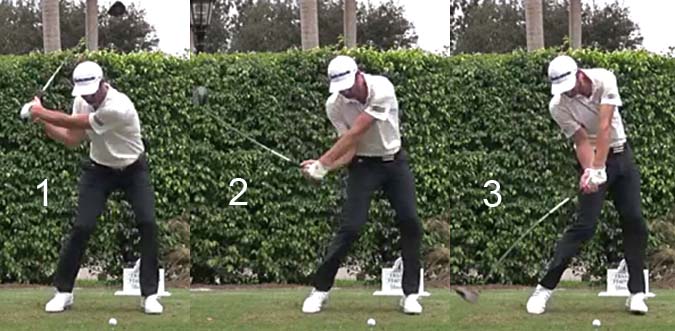
Image 1 shows Dustin Johnson at the P5 position. Note that he is adducting his
right upper arm so assertively that his right elbow is well below his left arm.
Image 2 is at the P5.5 position. Note that Dustin Johnson's right elbow is positioned well in front of his right hip area and that his "right elbow is leading his hands". With the right elbow in that position, the right forearm must be markedly supinated if the clubshaft and right palm are positioned parallel to a shallow swingplane.
Image 3 is at the P6.5 position. The forward bent clubshaft is due to a camera shutter-induced artifact. Note that his right forearm is still markedly supinated at that late stage of his downswing. Note that Dustin Johnson is not turning his right forearm counterclockwise (which Brandel Chamblee incorrectly believes is a mandatory requirement needed to prevent the clubshaft from moving underplane) and his clubshaft is not moving in an underplane manner.
Capture images of Kelli Oride's downswing action (from the following swing video - http://www.youtube.com/watch?v=p7hBadAiMcA )
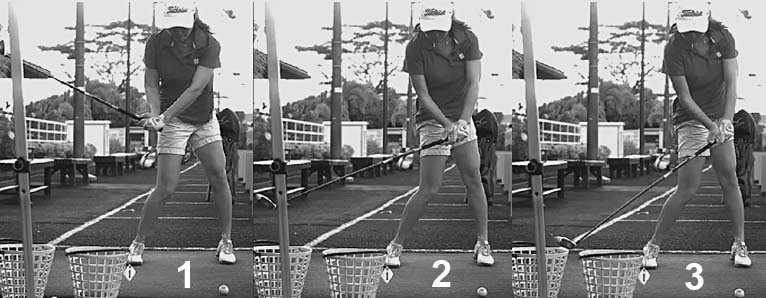
Image 1 is at the P5.5 position. Note that Kelli Oride doesn't assertively adduct
her right upper arm during her early downswing and her right elbow is still high
and far away from her right hip area. Note that her "hands are ahead of her
right elbow" (while Dustin Johnson's "right elbow is ahead of his hands" at the
P5.5 position). Her right forearm is still supinated, but not as much as Dustin
Johnson's right forearm at the comparable position.
Image 2 is at P6.25 and image 3 is at P6.5. Note that her right forearm is now less supinated, and it is much closer to a neutral position at the P6.5 position (while Dustin Johnson's right forearm is still markedly supinated at the comparable P6.5 position) - even though their left forearm is comparably neutral at the P6.5 position.
These two different golfer-examples demonstrate that the degree of right forearm supination that will likely exist at the mid-downswing's P5.5 position is very dependent on the degree of assertiveness of the right upper arm's adduction action during the early-mid downswing and its subsequent effect on the positioning of the right elbow at the P5.5 position.
By the way, I much prefer Dustin Johnson's right arm/forearm action (where his right forearm is significantly supinated between P5 and P6.5) because i) it allows him to more easily retain the maximum degree of lag for a longer time period; ii) it enables the right palm to more easily become parallel to the undersurface of a shallow clubshaft plane during the mid-downswing thereby optimally supporting the intact LAFW as it descends down the shallow swingplane; and iii) it decreases the chances of a "tumbling move" during the transition between the mid-downswing and the late downswing where the clubshaft is unintentionally thrown over-the-plane during the P5.5 => P6.2 time period.
Chapter 8 - Impact and Finish
Brandel Chamblee starts this chapter with the following comments-:
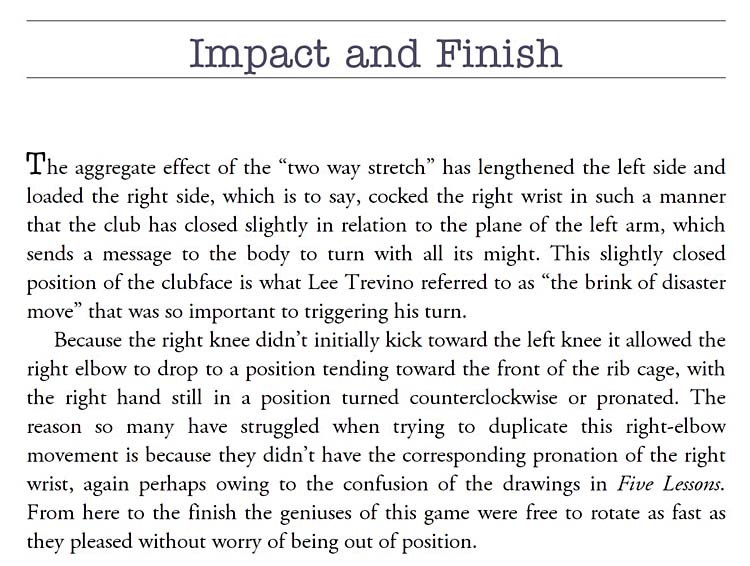
I disagree with all of Brandel Chamblee's comments in those two opening
paragraphs and I believe that they are reflective of significant deficiencies in his
understanding of golf swing biomechanics.
Brandel Chamblee writes about "loading the right side" which he deems to be a scenario where the right wrist is cocked causing the clubface to be closed to the plane of the left arm, which he also seemingly believes is a biomechanical position that "sends a message to the body to turn with all its might". First of all, the right wrist is not upcocked (radially deviated) at the P5.5 - P6 position, and it is only bent back (dorsiflexed). Also, the clubface is not closed to the plane of the left arm if a golfer has an intact LAFW and a weak-to-neutral left hand grip and if he uses an intact LAFW technique (rather than the combined "early left forearm supination + left wrist palmar flexion" technique, which *temporarily closes the clubface between P5.5 and P6.5). The clubface may be statically closed relative to the back of GFLW, and watchface area of the left lower forearm, if the golfer adopts a much stronger left hand grip at address, but that doesn't change the "fact" that a golfer, who has a moderately strong left hand grip (like Dustin Johnson and Keegan Bradley), still needs to use the two phases of left forearm supination in order to square the clubface by impact. It is a fallacy to believe that a golfer's body can simply "turn with all its might" in order to square the clubface by impact - without using a PA#3 release action (if the golfer adopts a weak-or-neutral-or-slightly strong left hand grip at address).
(* To understand why any clubface closure is only temporary during the execution of a combined "early left forearm supination + left wrist palmar flexion" action, see topic number 1 in the appendix section)
Note what Brandel Chamblee wrote regarding the position of the right hand when he stated-: "Because the right knee didn't initially kick towards the left knee it allowed the right elbow to drop to a position tending toward the front of the rib cage, with the right hand still in a position turned counterclockwise or pronated".
I have already demonstrated that the right forearm is not in a pronated position during the mid-downswing's P5 - P5.5 time period if the "right elbow leads the hands" and if the intact LAFW is optimally positioned on a shallow swingplane at P5.5, and I believe that Brandel Chamblee's claim that the reason why "so many have struggled when trying to duplicate this right-elbow movement is because they didn't have the corresponding pronation of the right wrist" is totally wrongheaded and meritless! I have even demonstrated that Greg Norman's right forearm must be supinated during the P5 to P5.5 time period because his "right elbow leads his hands" and because his RFFW is optimally oriented relative to his intact LAFW, which lies on a shallow swingplane. An optimal orientation of the RFFW (relative to the intact LAFW) causes the right palm to become parallel to the undersurface of the swing plane, and that "anatomical fact" mandates that the right forearm be supinated, and not pronated, during that P5 => P5.5 time period - if the right elbow is wedged in its pitch location near the right hip area.
Brandel Chamblee then continues to describe the downswing action in his book [1] with the following comments-: "The left side continues to extend and the body rotates as if it were revoving door, as opposed to a door on hinges. In addition, the left wrist flattens, or, in the case of weaker grip bows. This combination of movements causes the right side to bend laterally, bringing the right shoulder closer to the hip, and the head to move back."
I personally find the mental image of a "revolving door" of no value in terms of better understanding the pelvic/torso motion during the downswing. Also, Brandel Chamblee's claim that the left wrist flattens is untrue with respect to many professional golfers who maintain an intact LAFW/GFLW throughout their entire downswing action, and who therefore don't have to suddenly/artificially manufacture a "left wrist flattening" phenomenon later in their downswing.
His "cause-and-effect" claim that a rotating torso, combined with a flattened/bowed left wrist, causes right lateral bend makes no sense to me from a biomechanical perspective. Also, it is obvious that not all professional golfers develop a large amount of right lateral bend. Some professional golfers (like Dustin Johnson) develop a significant amount of lateral bend, while other professional golfers (like Phil Mickelson) do not develop a significant amount of right lateral bend (for reasons already discussed).
Regarding the critical topic of arm/forearm/wrist/hand motions through impact, the following few brief sentences represents the totality of the description that Brandel Chamblee provides in his book [1]-: "The left side, from the shoulder to the foot, is fully rotated and stretched, and the left arm and club form a line that is only slightly in front of the ball. The right arm has not fully released and the right wrist is still in extension or bent slightly back. An instant later after the ball is gone the right arm releases completely".
Brandel Chamblee never discusses the critically important issue of a drive-hold (DH) hand release action, versus a non-DH hand release action, through impact - and I think that this omission represents a major golf instructional deficiency.
Although Brandel Chamblee doesn't discuss the topic of hand release actions in his book, he does briefly comment on the topic of arm release actions. For example, Brandel Chamblee doesn't believe in the value of "swinging left", which I refer to as a CP-arm release action (where CP is an abbreviation of the term "centripetal") and he believes that a golfer should swing "out-and-up" in the direction of the target, which I refer to as a CF-arm release action (where CF is an abbreviation of the term "center-fleeing").
I personally believe that both arm release actions can be successfully used in a full golf swing, and here is a series of capture images showing Ben Hogan using the combination of a CP-arm release action ("swinging left" arm release action) and a no-roll hand release action.

Capture images from a Ben Hogan swing video
Note how quickly Ben Hogan's hands disappear from view after impact as he
"swings left".
Now, consider what Brandel Chamblee wrote in his "Swinging Down the Line" box, which I copied from his book [1].
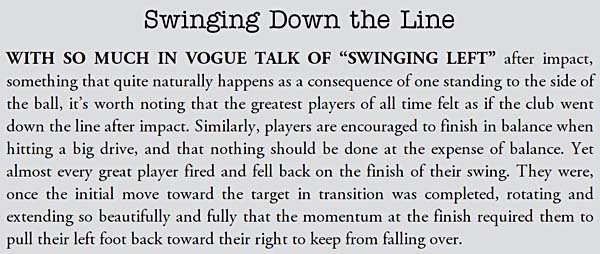
Note that Brandel Chamblee believes that "swinging left" happens "quite
naturally as a consequence of one standing to the side of the ball". I
disagree - because I believe that he is not using the term "swinging left" in
the correct manner if he thinks that all golfers must be
"swinging left" simply because they are standing to the side of the ball. An arm
release action relates to the motion of the left arm post-impact - as to whether
it moves inside-left of the ball-target line (CP-arm release action) or whether
it moves towards the target or slightly to the right of the ball-target line
(CF-arm release action). I think that a "swinging left" arm release action is an optional
choice, and that some professional golfers selectively prefer not to use a
CP-arm release action (like Ben Hogan) even though they are also "standing
to the side of the ball".
Consider an example of a professional golfer - Lee Trevino - who prefers not to routinely use a "swinging left " arm release action.
Lee Trevino capture image
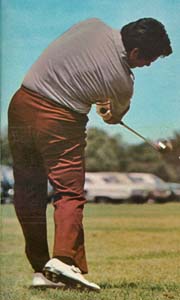
Lee Trevino routinely preferred to use a CF-arm release action, even though he
was obviously "standing to the side of the ball".
All professional golfers are obviously "standing to the side of the ball", but they all have the *option of using either a CP-arm release action or a CF-arm release action during their followthrough.
(* Note that I have described the different arm and hand release actions used by professional golfers in great detail in my "Impact and Followthrough" chapter and in a number of review papers relating to the topic of hand release actions)
Finally, I believe that Brandel Chamblee's claim that almost every great player "fired and fell back on the finish of their swing" and his second claim that they also had to "pull their left foot back toward their right to keep from falling over" has zero merit. Those two claims may definitely apply to a professional golfer who uses a *reverse-foot pattern of weight transfer during their downswing, but it certainly doesn't apply to a professional golfer who uses a front-foot pattern of weight transfer during their downswing and who also uses the I-finish pattern, rather than the reverse-C finish pattern.
(* I discussed the topic of different weight transfer patterns in topic number 13 of this review paper and I also described the different foot actions)
Consider the finish position of Gary Woodland, who I would classify as a "front-foot" golfer with respect to his weight-transfer pattern during his downswing action.
Back view video of Gary Woodland's driver swing - http://www.youtube.com/watch?v=Tb9Q-d9FWjQ
Capture images from the swing video.
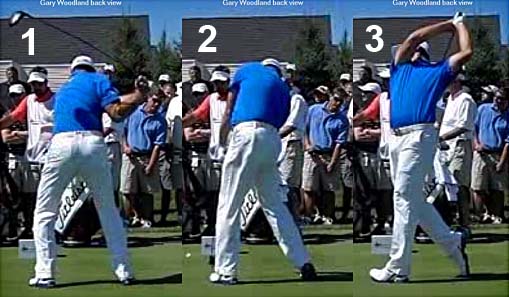
Image 1 is at the P5 position - end of the hip-squaring phase. Gary Woodland
likely has 50% of his overall COP-measurement under his left foot at this
end-of-the-early downswing time point.
Image 2 is at impact. Gary Woodland likely has ~75-80% of his overall COP-measurement under his left foot at impact - because he likely uses the "front-foot" pattern of weight transfer during his downswing action.
Image 3 is at his finish position. Note that Gary Woodland's upper torso is near-vertical over his straight left leg that is near-vertical, and that represents an I-finish posture. Gary Woodland is certainly not falling back at the finish of his swing action. Note that his left heel has remained solidly grounded throughout his downswing and also throughout his followthrough/finish, and he never pulls his left foot back towards his right foot.
Now, consider the finish position of Adam Scott, who is widely regarded by his peers as having one of the "best" golf swing actions.
Adam Scott swing video - https://www.youtube.com/watch?v=xv51tEUSmiA
Capture image from the swing video showing Adam Scott's finish position.
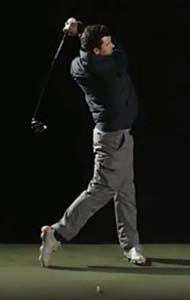
Note that he also has an I-finish position and that he doesn't
"hang back". Note that his left heel remains solidly grounded throughout his
entire downswing and followthrough swing action, and that he doesn't "pull his
left foot back towards his right foot".
Although the I-finish position is very suitable for a golfer who uses a "front foot" pattern of weight-transfer during the downswing, I think that it would not be suitable for a golfer - like Bubba Watson - who likely uses the "reverse foot" pattern of weight-transfer during the downswing.
Consider the "look" of Bubba Watson at the P8 position.
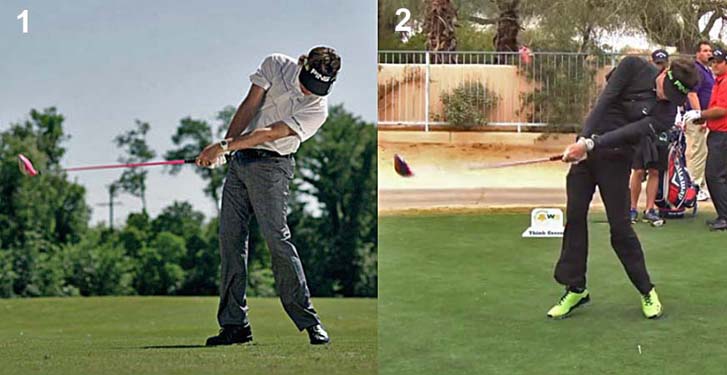
Images captured from two different driver swings
Note that Bubba Watson has a large amount of secondary axis tilt with his head
almost over his rear foot, and he looks like he is "falling back".
Note that the heel of his lead foot is being pulled back towards his rear foot in a spinning manner.
Because these two very different weight-transfer patterns exist in professional golfers, I would advise developing golfers to better understand their weight-transfer pattern (in terms of likely COP-measurements under the lead foot during the downswing) before they choose to adopt a particular finish position, and a particular foot action, for their individual full golf swing action.
Concluding remarks:
If you consider the title of Brandel Chamblee's book "The Anatomy of
Greatness", a potential reader of that book can easily anticipate in advance that Brandel Chamblee's central
thesis in his book is going to be the thesis that specific biomechanical
elements, that are frequently seen in his arbitrarily selected group of
"greatest golfers", are causally responsible for their "greatness". However,
after actually reading his book, a discerning reader should be capable of rationally concluding that Brandel Chamblee has
not demonstrated a causal connection between any
of those "specific biomechanical elements" and an individual golfer's ability to
become one of the world's "greatest golfers". He never demonstrated in his book that those
specific biomechanical elements were primarily used by those
"greatest golfers" and that they were not routinely used
by their peers (fellow professional golfers who were playing on tour during the
same time period). As an example, based on my study of many professional
golfers, I think that Sam Snead's peers used a similar swing style during the
1940-1960 time period and that there is no "evidence" that Sam Snead used a
different set of biomechanical elements. So, as a practical example of an
individual golfer's chosen
swing technique, although Sam Snead used the combination of a "full clockwise pelvic
rotation + left heel lifting" during his backswing action, he didn't perform it
significantly differently to many of his peers, who used the same pelvic loading technique
during their backswing action.
The same conclusion applies to many other "specific biomechanical elements" that
Brandel Chamblee particularly favors (eg. triggering elements, one-piece takeaway
performed while resisting any clockwise rotation of the left forearm, late
"setting of the wrists") - there is no "evidence" that his arbitrarily selected group of
"greatest golfers" were the only professional golfers who used these "specific biomechanical elements", while their less
successful peer professional golfers did not use the same biomechanical
elements.
Although there is obviously no incontrovertible "cause-and-effect" connection between the use of "specific biomechanical elements" and the remarkable feat of becoming one of the world's "greatest golfers", it is certainly reasonable for Brandel Chamblee to argue that he believes that those "specific biomechanical elements" are conducive to better ball-striking. However, he then needs to base his arguments on sound biomechanical/mechanical reasoning, and considering the multiplicity of criticisms that I have expressed in this book review paper, it must be obvious to any reader of this review paper that I personally do not think that Brandel Chamblee's arguments on behalf of those "specific biomechanical elements" are based on sound biomechanical/mechanical reasoning.
In his book's introduction, Brandel Chamblee also suggests (from a golf instructional perspective) that his book may be the "last book" that a developing golfer will ever need. That assertion seemingly implies that Brandel Chamblee believes that his book can be considered to be a "definitive" golf instructional book. Although I certainly cannot agree with the idea that Brandel Chamblee's book should be considered to be a "definitive" golf instructional book, I think that each reader should independently make up his own mind about this issue. Each individual reader of this book review paper will obviously have to use his own independent judgment to decide whether he is persuaded by Brandel Chamblee's reasoning and expressed arguments, or whether he finds my reasoning and expressed counterarguments more persuasive. Irrespective of his final personal decision, I hope that each reader of this book review paper will find the juxtaposition of our contrary opinions (regarding the many topics that were discussed in this book review paper) intellectually interesting, and maybe even illuminating.
Jeffrey Mann.
First version: June 2116.
Appendix section:
Question:
Is the clubface closure that happens between P5.5 and P6.2 during the execution of a combined "early left forearm supination + left wrist palmar flexion" action temporary, or does it persist all the way to impact?
Answer:
This is a complex topic, and I will try to provide a simple, but coherent, explanation.
Brandel Chamblee posted this image of Ben Hogan at the P6 position in his book [1]
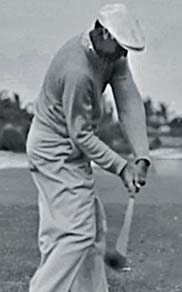
Brandel Chamblee implied that Ben Hogan's clubface was slightly closed (relative
to the clubhead arc) due to the fact that he was pronating his right forearm. He
then implied that Hogan could simply rotate his body into impact from that P6
position and that he would automatically have a square clubface at impact
because he had already closed his clubface by his P6 time period.
I believe that both claims are wrong, and I believe that I can easily prove that both claims are wrong.
Consider my explanatory proof.
Why is Ben Hogan's clubface slightly closed relative to the clubhead arc at that mid-downswing time period?
I believe that it is due to the fact that he is using the combined "early left forearm supination + left wrist palmar flexion" technique.
I strongly suspect that Brandel Chamblee got this "clubface-closing" idea from Jeff Martin, a swing disciple of Kelvin Miyahira and Lucas Wald.
Here is a smaller-sized version of an animated gif that was originally created by Jeff Martin.
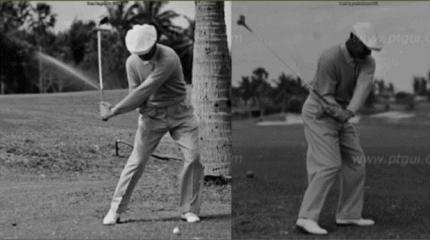
The animated gif consists of two images - the first image is at P5.5 and the
second image is at P6.1.
Note that Ben Hogan has a slightly cupped left wrist at the P5.5 position, and that his clubface is open to the clubhead arc, but roughly parallel to the watchface area of his left lower forearm. By the P6.1 position, he has acquired a bowed left wrist and his clubface is slightly closed relative to his clubhead arc and also relative to the watchface area of his left lower forearm by ~30 degrees. Note that Ben Hogan's left forearm is also more supinated at the P6.1 position relative to the P5.5 position.
Kelvin Miyahira and Jeff Martin used this animated gif of Ben Hogan to demonstrate that the combined technique of "early left forearm supination + left wrist palmar flexion" closes the clubface by ~30 degrees during the P5.5 => P6.2 time period. I don't disagree with their demonstration. In fact, I will use the swing of Gary Woodland (who also uses that same technique) to demonstrate that this "clubface-closing" phenomenon really does happen during that P5.5 => P6.2 time period, but I will also demonstrate that the clubface-closing effect is temporary and that it dissipates before impact.
Most professional golfers do not use the combined technique of "early left forearm supination + left wrist palmar flexion" and they use the intact LAFW technique.
Henrik Stenson is an example of a golfer who uses the intact LAFW technique and consider what happens to his clubface during the P5.5 => P6 time period.
Capture images from Henrik Stenson's swing video.
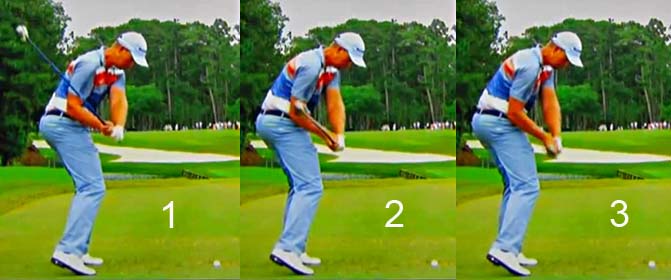
Image 1 is at the P5.25 position. Note that Henrik Stenson has an intact LAFW
and GFLW, which are parallel to his shallow swingplane. Also, note that his
clubface is neutral/parallel relative to the back of his GFLW and the watchface
area of his left lower forearm, but his clubface is open relative to his
clubhead arc.
Image 2 is at the P5.5 position. Note that Henrik Stenson has started to supinate his left forearm by a small amount and that causes the back of his GFLW to become more vertical, and less horizontal. However, he still has an intact LAFW and GFLW and his clubface is still neutral/parallel relative to the back of his GFLW and watchface area of his left lower forearm, but open relative to the clubhead arc.
Image 3 is at the P6 position. Note that Henrik Stenson has supinated his left forearm slightly more so that the back of his GFLW and watchface area of his left lower forearm is now vertical to the ground. Note that he still has an intact LAFW and a GFLW. Note that his clubface is vertical (with the toe pointing straight up), but the clubface is still neutral/parallel relative to the back of his GFLW and watchface area of his left lower forearm, although it is open relative to his clubhead arc.
In other words, there is no "clubface-closing" phenomenon between P5.5 and P6 if a golfer uses an intact LAFW technique.
Now, consider Gary Woodland's swing action - remembering that Gary Woodland uses the same combined "early left forearm supination + left wrist palmar flexion" technique that was seemingly used by Ben Hogan in that animated gif.
Capture images from a Gary Woodland swing video.
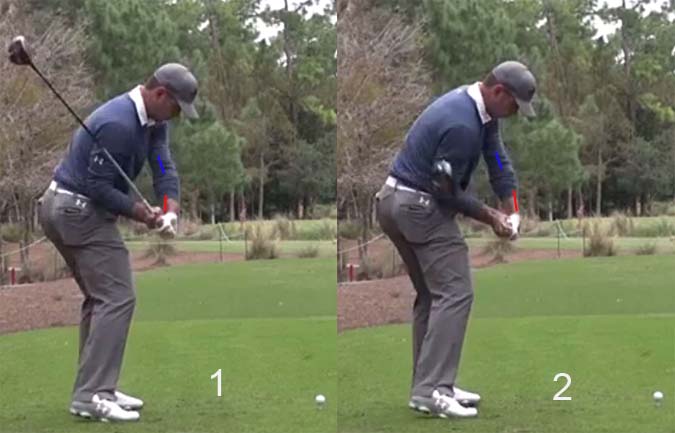
Image 1 is at the P5.25 position. Note that Gary Woodland has an intact LAFW and
a GFLW. Note that his clubface is neutral/parallel to the back of his GFLW and
the watchface area of his left lower forearm, but it is open relative to the
clubhead arc. I have drawn a blue line down the center of his left antecubital
fossa as a reference point. I have drawn a red line along his left radial bone
just above his glove and it is turned slightly clockwise relative to the blue
line, indicating that his left forearm is slightly pronated.
Image 2 is at the P5.5 position. Note that Gary Woodland now has a bowed (palmar flexed) left wrist and that his left forearm is overtly supinated (note that the red line is turned more counterclockwise relative to the blue line). Note that his clubface is now closed by ~30 degrees relative to the watchface area of his left lower forearm and that it is also ~30 degrees less open relative to the clubhead arc.
The same "clubface-closing" phenomenon can be seen in face-on capture images.
Capture images from a face-on swing video of Gary Woodland's swing.

Image 1 is at the P5 position. Gary Woodland has an intact LAFW and a GFLW that
is parallel to his swingplane. Note that his clubface is neutral/parallel to the
back of his GFLW and watchface area of his left lower forearm.
Image 2 is at the P5.5 position. Note there is now the first visual evidence that Gary Woodland is starting to supinate his left forearm and bow (palmar flex) his left wrist and that combination causes his clubface to be slightly less open relative to his clubhead arc.
Image 3 is at the P6 position, and one can clearly see that Gary Woodland is using the combined technique of "early left forearm supination + left wrist palmar flexion) and that it causes his clubface to close by ~30 degrees relative to the watchface area of his left lower forearm and also relative to his clubhead arc. Note that his clubface is not vertical at the P6 position, and that the toe of the club is tilted more towards the ground.
Image 4 is at the P6.2 position. Note that the clubface is still closed by ~30 degrees relative to the watchface area of his left lower forearm, and that it is ~30 degrees less open to the clubhead arc.
In other words, Gary Woodland is manifesting the same "clubface-closing" phenomenon that Ben Hogan manifested in that Hogan image that Brandel Chamblee used in his book.
Now, let's consider two questions-: i) Is the "clubface-closing" phenomenon due to the fact that Gary Woodland has a pronated right forearm that causes the right palm to face groundwards and ii) does the "clubface-closing" phenomenon persist until impact - thereby enabling Gary Woodland to avoid using a standard PA#3 release action (primarily due to phase 2 of left forearm supination), which is usually used to square the clubface by impact if a golfer uses the intact LAFW technique (like Henrik Stenson)?
Consider this close-up image of Gary Woodland's right forearm at the P6.2 position (derived from capture image 4 above) .
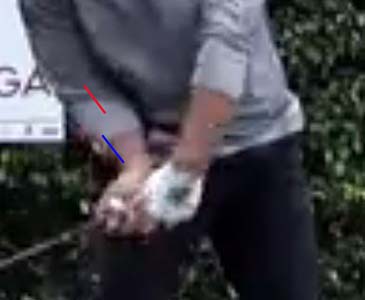
I have drawn a red line on the ventral surface of his right upper forearm,
starting the proximal end of the red line at the center of Gary Woodland's right antecubital
fossa, and that red line acts as a reference point. I have drawn a blue line along his radial bone just
above his right wrist crease (= crease between the back of his dorsiflexed right
hand and the dorso-radial side of his right lower forearm).
I believe that it is visually incontestable that Gary Woodland's right lower forearm is rotated clockwise (as if he were losing an arm wresting match) and that his right forearm is supinated, and not pronated. Note that his right palm is near-vertical and roughly parallel to the back of his bowed left hand, which is near-vertical - and his right palm is not facing groundwards. That "fact" proves that the "clubface-closing" phenomenon (which happens between P5.5 and P6.2) is not causally due to Brandel Chamblee's "false-claim" that a golfer must have his right forearm in a frankly pronated position (where the right palm faces groundwards) in order to close the clubface relative to the clubhead arc during the mid-downswing.
The same visually incontestable "fact" applies to Ben Hogan's right forearm in that animated gif created by Jeff Martin.
Here is a face-on capture image of Ben Hogan at the P6.1 position (which I copied from that animated gif).
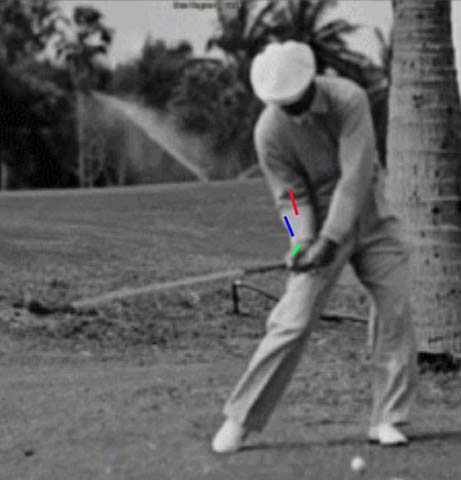
Note that I have drawn a red line through the center of Ben Hogan's right antecubital fossa as a reference point. I have also drawn a blue line along his radial bone at the level of his lower right forearm, and that blue line is located just above his right thumb. I have also drawn a green line over his right thumb's metacarpal bone - note that it is angled about 45 degrees to the right of the red line.
I believe that it is visually incontestable that the blue line is well to the right of the red line, which means that Ben Hogan's right forearm must be supinated, and not pronated, at that time point. If you are not convinced - try this simple experiment. Get into a golfer's posture (like Ben Hogan at the P6.1 position), and then position your right upper arm like Ben Hogan's right upper arm - where the right upper arm is adducted against the right side of the body and where the right elbow is wedged in its pitch location in front of the right hip, and where the right antecubital fossa faces the ball-target line. Then rotate your right forearm clockwise until your right thumb's metacarpal bone is angled about 45 degrees to the right relative to your right antecubital fossa (mimicing the green line in the Ben Hogan image). Note that your right palm faces partially skywards and note that your right forearm is supinated, and not pronated. If you want to "feel" what it would be like to have a pronated right forearm at that same position, then simply rotate your right forearm counterclockwise until your right thumb's metacarpal bone is angled about 45 degrees to the left relative to your right antecubital fossa. Note that your right palm faces partially groundwards. The neutral position is when the right palm is vertical, and when the right palm neither partially faces the sky or partially faces the ground, and when the right thumb's metacarpal bone is straight-in-line with the right antecubital fossa.
Now, let's consider whether Gary Woodland's "clubface-closing" phenomenon persists until impact - thereby suggesting that he doesn't have to use the standard amount of left forearm supination during his PA#3 release action in order to square his clubface by impact.

Image 1 is at the P6.2 position. Note that Gary Woodland's clubface is still
closed by ~30 degrees relative to the watchface area of his left lower forearm,
and that it is ~30 degrees less open to the clubhead arc.
Image 2 is at the P6.5 position. Note that his clubface appears to be slightly less than ~30 degrees closed relative to the watchface area of his left lower clubhead arc and that it is also slightly less than ~30 degrees less open relative to his clubhead arc.
Image 3 is at P6.8. Note that his clubface is now far less than 30 degrees closed relative to the watchface area of his left lower forearm.
Image 4 is at impact. Note that his clubface is now neutral/straight-in-line relative to the watchface area of his left lower forearm. Note that the back of his left lower forearm (watchface area), back of his bowed left hand and clubface are all square to the target.
In other words, the "clubface-closing" phenomenon (relative to the watchface area of his left lower forearm and relative to the clubhead arc) dissipated in his later downswing as his left wrist moved increasingly in an ulnar (left wrist uncocking) direction.
Now, consider whether Gary Woodland used the *standard amount of left forearm supination during his PA#3 release action, that naturally/automatically happens during the late downswing between P6.5 and impact.
(* the standard amount of left forearm supination happening during a PA#3 release action is inversely proportional to the strength of the left hand grip - and it is important to remember that both Gary Woodland and Henrik Stenson adopt a neutral left hand grip at address).
Look at the directional position of Gary Woodland's left radial bone just above his glove, or look at the logo on the back of his glove, in image 2 (which is at the P6.5 position) and also in image 4 (which is at impact). Note how much they have rotated counterclockwise during the P6.5 => impact time period, and note that the amount reflects the standard amount of left forearm supination that normally happens during a PA#3 release phenomenon. Note that Gary Woodland, who uses the combined "early left forearm supination + left wrist palmar flexion" technique, manifests *nearly the same amount of left forearm supination between P6.5 and impact as manifested by a golfer (like Henrik Stenson) who uses an intact LAFW technique. This "fact" provides secondary proof that the "clubface-closing" phenomenon due to the use of a combined "early left forearm supination + left wrist palmar flexion" technique is temporary, and that it dissipates by impact.
(* Note that Gary Woodland's left radial bone is perpendicular to the ball-target line at impact, which means that it is actually more rotated counterclockwise than Henrik Stenson's left radial bone at impact - and that is fully expected because Gary Woodland has a bowed/palmar flexed left wrist at impact while Henrik Stenson has a GFLW at impact)
Here is a composite image of Henrik Stenson and Gary Woodland at impact.
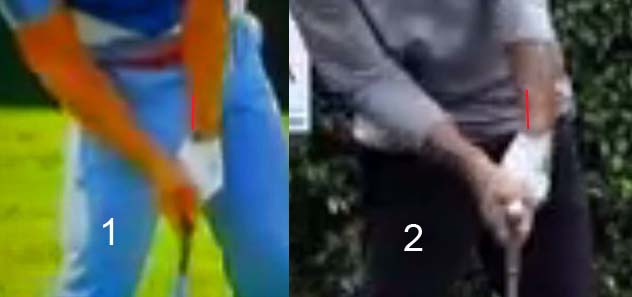
Image 1 shows Henrik Stenson at impact, and image 2 shows Gary Woodland at impact.
I have drawn a red line over their radial bone at the level of their lower left forearm.
Note that one can see slightly more of the watchface area of Henrik Stenson's lower left forearm from a face-on camera viewing perspective (compared to the watchface area of Gary Woodland's lower left forearm) because Henrik Stenson's left lower forearm is less rotated counterclockwise than Gary Woodland's left lower forearm. The difference is very small, but it does demonstrate that having a bowed left wrist at impact means that a golfer has to rotate the left forearm slightly more counterclockwise during his PA#3 release action in order to get a square clubface at impact. The comparison image also demonstrates that Gary Woodland, who uses the combined "early left forearm supination + left wrist palmar flexion" technique, still has to use a full PA#3 release action in order to get a square clubface by impact, and that he doesn't use less counterclockwise rotation of his left forearm simply because he temporarily closed his clubface (relative to the clubhead arc) during the P5.5 => P6.5 time period due to the use of a combined "early left forearm supination + left wrist palmar flexion" technique.
By the way, I have used a swing analyser program to examine a fair number of swings of other professional golfers, who use the combined "early left forearm supination + left wrist palmar flexion" technique, and in all cases the "clubface-closing" phenomenon is shown to be a temporary phenomenon, requiring the use of the standard amount of left forearm supination between P6.5 and P7 in order to get a square clubface by impact.
Topic number 2:
Question:
Brandel Chamblee often refers to the "stretch-shortening cycle" biomechanical
phenomenon in his book [1]. Do I believe that his claims about the "stretch-shortening cycle" phenomenon
are valid?
Answer:
No!
I believe that Brandel Chamblee's multiple claims in his book [1] regarding the "stretch-shortening cycle" phenomenon are not biomechanically, or scientifically, valid.
Consider this comment that Brandel Chamblee made in a box in his book [1].
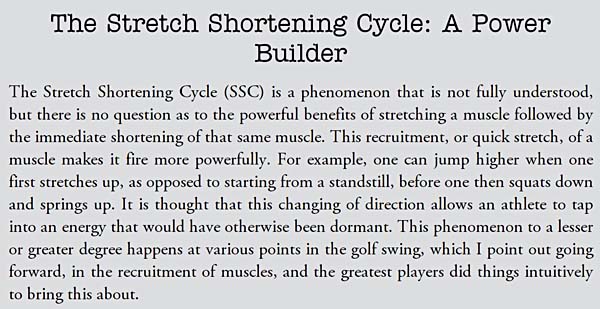
I think that his description of the stretch-shortening cycle is partially inaccurate. He is correct to state that if an individual muscle is first stretched, and if that same muscle immediately contracts without any delay, that the individual muscle can contract with greater power.
So, consider jumping up from a squat position. If one stands semi-erect (eg. in a golfer's posture), and if one then squats down and holds that squat position for a few seconds, then one is obviously passively stretching the knee extensor muscles when in the squat position, which pre-loads the muscle. If one then jumps up from that static squat position (where the knee extensor muscles are optimally pre-loaded), then one can jump up to a finite vertical height - and we can assign it a magnitude value of "X". Alternatively, if one starts off from the same semi-erect position, and if one then squats down to a squat position, and if one then immediately jumps up from that dyanamic squat position without any delay, then one can jump up to a vertical height that is more than the finite amount - and we can assign it a magnitude value of (X + Y). The extra amount Y is thought to be due to the storage, and immediate release, of elastic energy (although the exact explanation is highly debatable - see reference number [10]). However, it has nothing to do with first stretching up from a semi-erect posture to a more erect posture, as opposed to starting from a semi-erect posture and it has nothing to do with the idea of recruiting more muscles. It fundamentally involves the dynamic stretching of an individual muscle where there is no delay between the stretch cycle and the shortening cycle.
Also, it is important to appreciate the fact that the amount of extra vertical height obtained in that squat-jump scenario is not necessarily that large. For example, in a study by Komo and Bosco, which involved 44 subjects, this was their study's protocol-: "The squat jump begins from a squat position (knee angle about 2 rad) and simply involves an extension of the knee and ankle joints; the arms kept outstretched overhead to minimise their contribution to the jump. The countermovement jump begins from an upright posture, and involves, in one continuous movement, squatting down to a knee angle of about 2 rad, and then immediately extending the knee and ankle joints as in the squat jump".
This was the study's results.
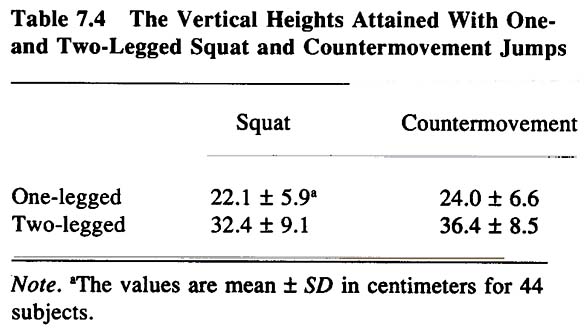
Note that in the one-legged jump, adding the countermovement stage increased the
vertical height values by 2cm from 22cm to 24cm, and in the two-legged jump,
adding the countermovement stage increased the vertical height values by 4cm
from 32.4cm to 36.4 cm.
In summary, the critical point in a stretch-shortening cycle event, is that there must be no delay between the dynamic stretching and subsequent active shortening of the individual muscle (that happens secondary to a concentric contraction of that muscle).
With that background information on the fundamental principles of a stretch-shortening cycle, consider how Brandel Chamblee invokes the stretch-shortening cycle in a full golf swing.
Brandel Chamblee seemingly claims that a "late setting of the wrists" invokes a stretch-shortening cycle that causes the left wrist to uncock with greater power. I believe that he is wrong for a number of reasons. First of all, according to the fundamental principles of the stretch-shortening cycle, there must be no delay between the dynamic stretching of a particular muscle and the contraction phase of that same muscle. I can only presume that he must be thinking of stretching the left forearm muscle (extensor carpi ulnaris) which can theoretically ulnar deviate the left wrist if it actively contracts - because it is the primary left forearm muscle which can actively move the left wrist in an ulnar-deviation direction (left wrist uncocking direction) if it actively contracts. I believe that there are no other muscles in the left hand and left wrist zone that can cause ulnar deviation of the left wrist. However, if that left forearm muscle (extensor carpi ulnaris) is stretched during a "late setting of the wrists" action, then the stretch-shortening cycle phenomenon can only be regarded as being operant if that same muscle actively contracts without any delay. The reality, of course, is that nearly all skilled professional golfers delay their left wrist uncocking motion to the mid-downswing (when the club first starts to release) and there is no left wrist uncocking action happening between P4 and P5.5, which means that there is a considerable time-delay period between P4 and P5.5. That time-delay means that the stretch-shortening cycle cannot be applicable to the left wrist uncocking action, which only happens during the club releasing phase of the downswing. Another reason why I do not think that a stretch-shortening cycle can apply to the left wrist uncocking phenomenon, is the "fact" that most golf theorists (like me) believe that the club release phenomenon happens according to the laws of physics (= law of the double pendulum swing model, which some people think of as being a "centrifugal release" phenomenon) and that it doesn't happen secondary to any active muscle contraction of the extensor carpi ulnaris muscle in the left forearm.
Amazingly, Brandel Chamblee even thinks that having the right wrist pronated during the mid-backswing can invoke a stretch-shortening cycle. Consider again what Brandel Chamblee wrote in the following box, which I copied from his book [1].

In that box, Brandel Chamblee claimed-: "The position of the right hand sets
up a stretch shortening cycle (outlined earlier) in the transition from
backswing to downswing, in the smaller muscles of the wrist and forearm that
generate a great deal of power." Brandel Chamblee doesn't specify which
particular smaller muscles he is referring to in that claim, and whether they are in the
left or right upper limb, and he doesn't even explain how contraction of those
"unspecified" smaller muscles can generate swing power. He also doesn't explain how
any pronatory position of the right palm in the mid-backswing (which
only exists if a golfer uses an one-piece takeaway and if he also temporarily
resists any left forearm pronatory motion) can induce an active stretching of
the "unspecified muscles" that will subsequently contract, and he certainly
doesn't explain how the stretch-shortening cycle can be operant if there is a
significant time-delay between the stretching of the "unspecified muscles" and
their active contraction. I personally don't know of any
smaller muscles in either the left-or-right forearm that can significantly contribute to swing
power in a golfer who uses a TGM-swinging action (which is the swing technique
used by the majority of professional golfers), and I certainly don't
understand how any right forearm pronatory position/motion during the backswing
could cause a stretch-shortening cycle of those "unspecified muscles"
without any time-delay between the stretching phase and the muscle
contraction phase.
References:
1. The Anatomy of Greatness.
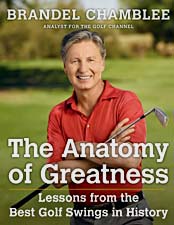
2. Swing Like a Pro. Dr. Ralph Mann and Fred Griffin.
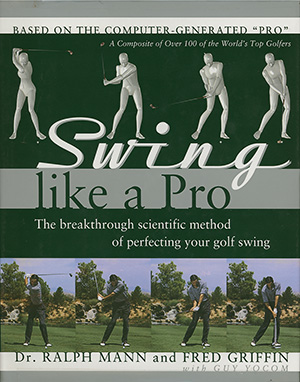
3. A Swing for Life. Nick Faldo.
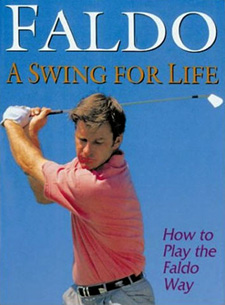
4. The Golf Swing. David Leadbetter.

5. The Complete Encyclopedia of Golf Techniques.

6. The Golfing Machine. Homer Kelly.
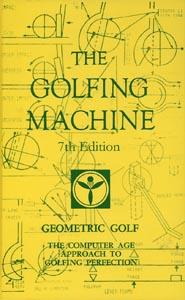
7. Golf-Related Low Back Pain: A Review of Causative Factors and Prevention
Strategies. David M. Lindsay and Anthony A. Vandervoort. Asian Journal of Sports
Medicine. Volume 5 (4). December 2014.
Full text article publically available online at http://www.ncbi.nlm.nih.gov/pmc/articles/PMC4335481/
8. The Biomechanics of the Modern Golf Swing: Implications for Lower Back
Injuries. Michael H. Cole and Paul N. Grimshaw. Sports Medicine. 2016 Mar;
46(3):339-51.
Abstract available at http://www.ncbi.nlm.nih.gov/pubmed/26604102. You can also contact the lead author at michael.cole@acu.edu.au if you want to acquire a full text copy of the review article.
9. Phil Cheetham's PhD dissertation paper.
Available at http://www.philcheetham.com/phd-dissertation-and-presentation
9a. Cheetham P. (2014) The relationship of club handle twist velocity to selected biomechanical characteristics of the golf drive. Doctoral dissertation. http://www.philcheetham.com/media/Phillip-Cheetham-Doctoral-Dissertation-2014.pdf
9b. Phil Cheetham's Powerpoint Presentation in Defense of his PhD Dissertation.
http://www.philcheetham.com/media/Phillip-Cheetham-Dissertation-Powerpoint-2014.pdf
10. The Great Stretch Shorten Cycle Debate. Robert U. Newton. PhD.
Available at http://www.innervations.com/v1/resources/sscdebate.htm